Francesca and Henk-Jan's Backpacking Trip!
Tuesday, March 30, 2010
Angkorian Architecture
We jumped back in the tuk-tuk, talking a bit to Wanny whilst Angkor came closer and closer. In the pitch dark the tuk-tuk stopped and within seconds little kids were offering us coffee: “Heeeellooooo miiiiisteeeerrrrr! You wan coffeeeee miiiiisteeerrrr?” Replace ‘coffee’ with water, flutes, bracelets, postcards or books and you’ll have an idea of what happened everywhere we went. The piercing sound of the shrill voices of mothers and their children was something we had to, but couldn’t get used to in the following days…
Wanny led us past the checkpoint, where our passes got checked and they let us through. We walked down the 200 meter long causeway, which for a small part still has original stone. The causeway led us over the gigantic moat and to the gopura (entrance building). We almost tripped over the large steps, but managed to stay in piece, emerging on a second causeway. The second, 350 meter long and 8,5 meter wide Naga causeway took us to the sunrise viewing area. Wanny had us sit down on one of the libraries and shared a little information about the history of Angkor Wat:
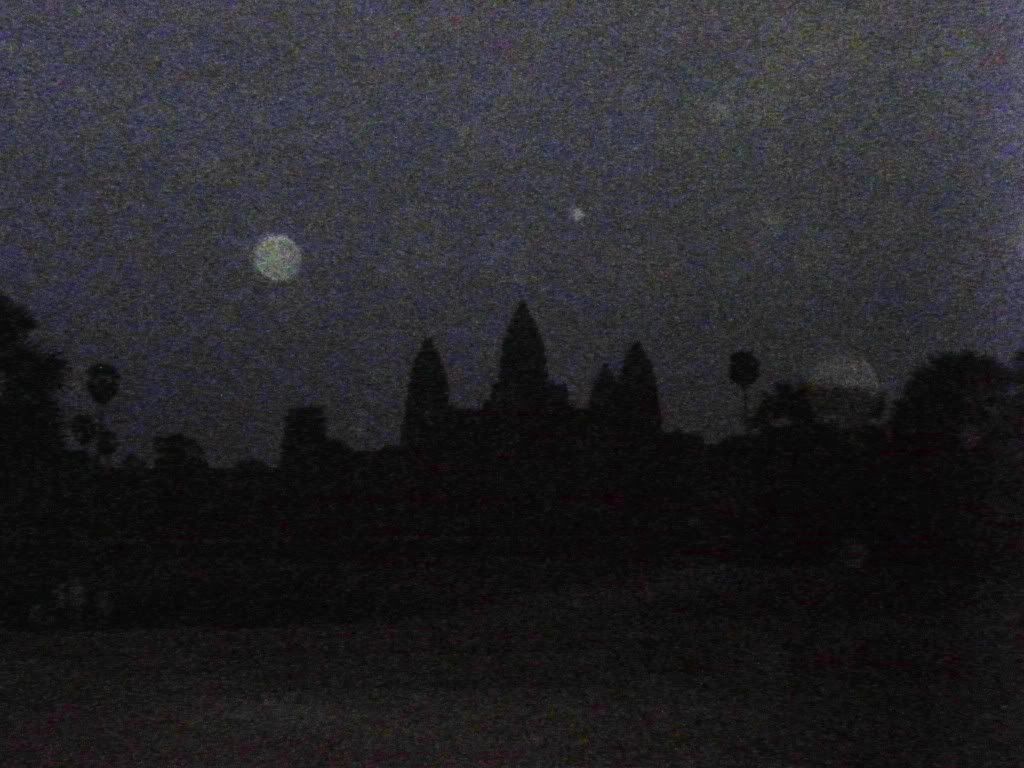
“The initial design and construction of the temple took place in the first half of the 12th century, during the reign of Suryavarman II (ruled 1113 – c. 1150). Dedicated to Vishnu, it was built as the king's state temple and capital city. As neither the foundation stela nor any contemporary inscriptions referring to the temple have been found, its original name is unknown, but it may have been known as Vrah Vishnulok after the presiding deity. Work seems to have ended shortly after the king's death, leaving some of the bas-relief decoration unfinished.”
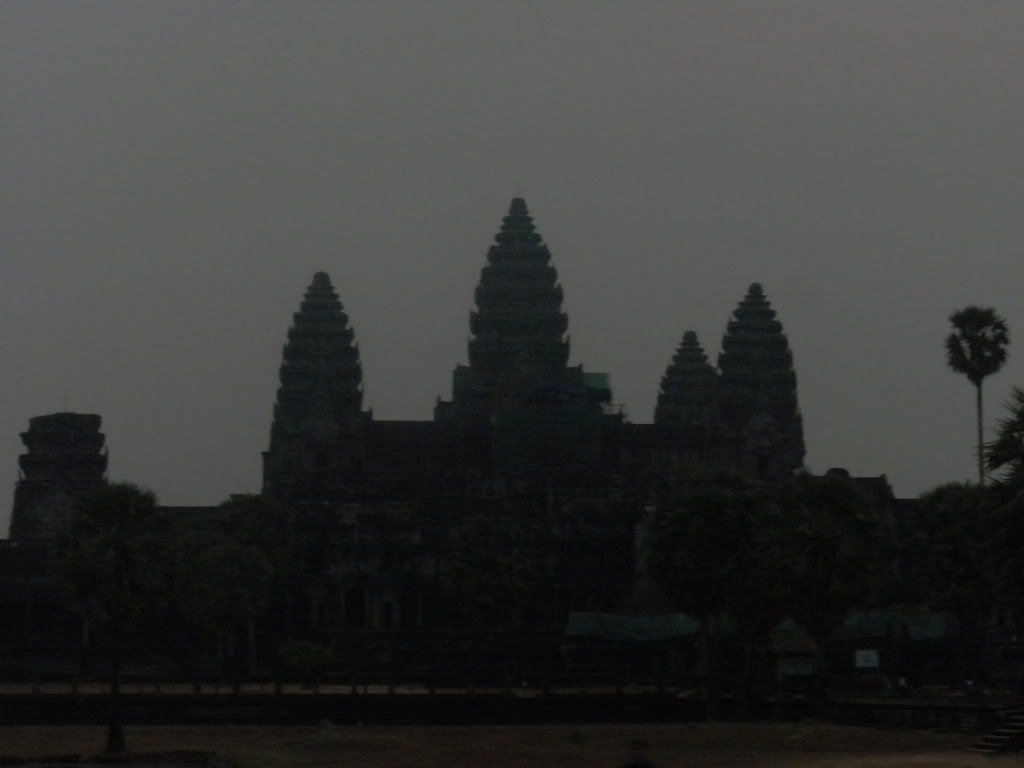
Perhaps the temple was built as a funerary temple for Suryavarman II. The fact that the temple is dedicated to Vishnu (the destroyer) seems to support this sentiment. Furthermore, the temple faces the west, something unusual for temples made during those years. The west is the wind direction of Yama, God of Death.
So there we were, sitting down on an ancient Khmer building, the silhouette of Angkor Wat looming in the distance. Not entirely to our surprise we found out once again that our camera is not capable of capturing dawn properly. The pictures don’t do the sunrise just, but I hope they give you an idea of our view. And, as with sunrise at Ayers’ Rock, we suffered from a clouded sky once again. Shame! When we realized sunrise wouldn’t get much better we moved forward a little to look at the reflection of Angkor Wat in a pool in front of the temple. Combined with the water lilies and the stillness of the water this made for some neat pictures.
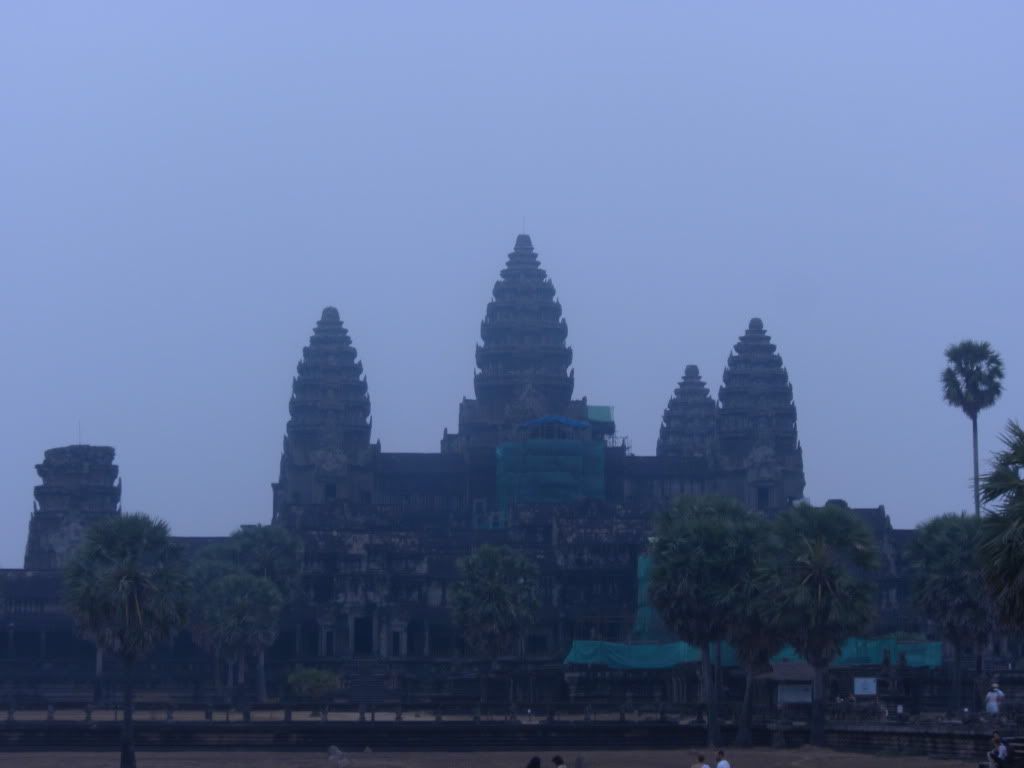
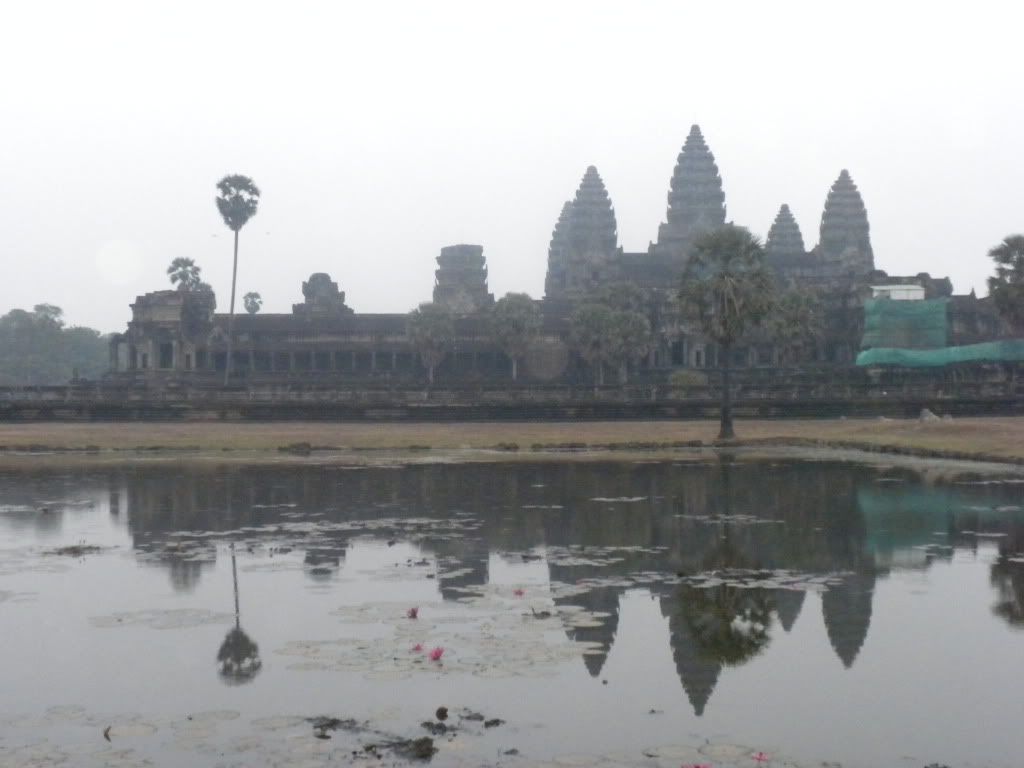
We decided to leave the hordes behind and walked around the left side of the little lake onto the first stones of Angkor Wat proper. We entered the temple‘s outer gallery, spotting the first amazing carvings. A Garuda with wings spread gave us our first glance at the talent of the artisans involved in the creation of the temple. We followed the gallery towards the central entrance, exploring the intricate stories on the walls to the left of us. The first carvings, as Wanny explained, told the story of the battle of Lanka. We both recognized scenes from the Ramayana (remember Indonesia!) and saw how Rama, with help from his allies the monkeys, recaptured the lovely Sita. We were amused by carvings of females which, through extensive touching by passers-by, had certain parts of their bodies brightly polished and glowing.
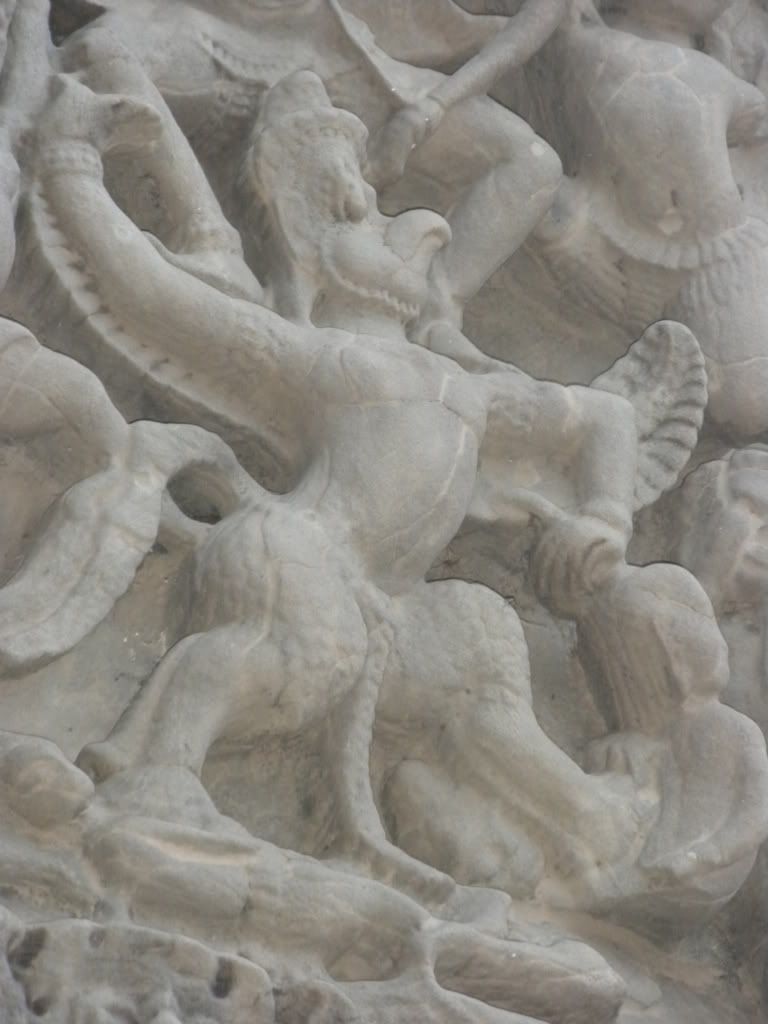
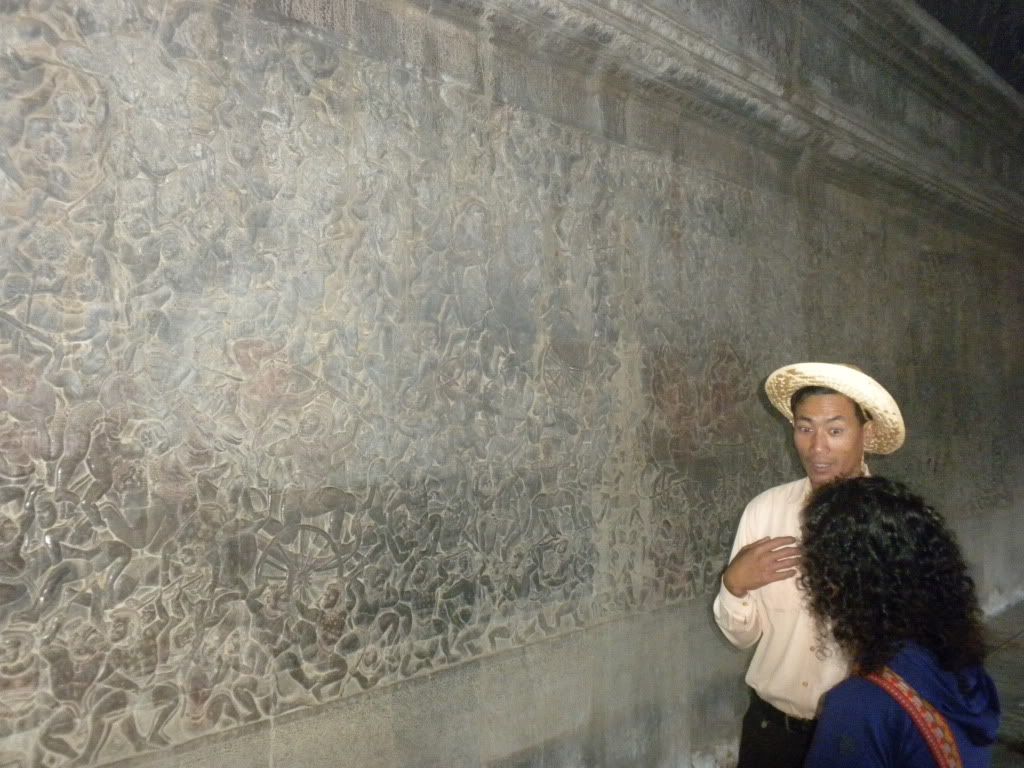
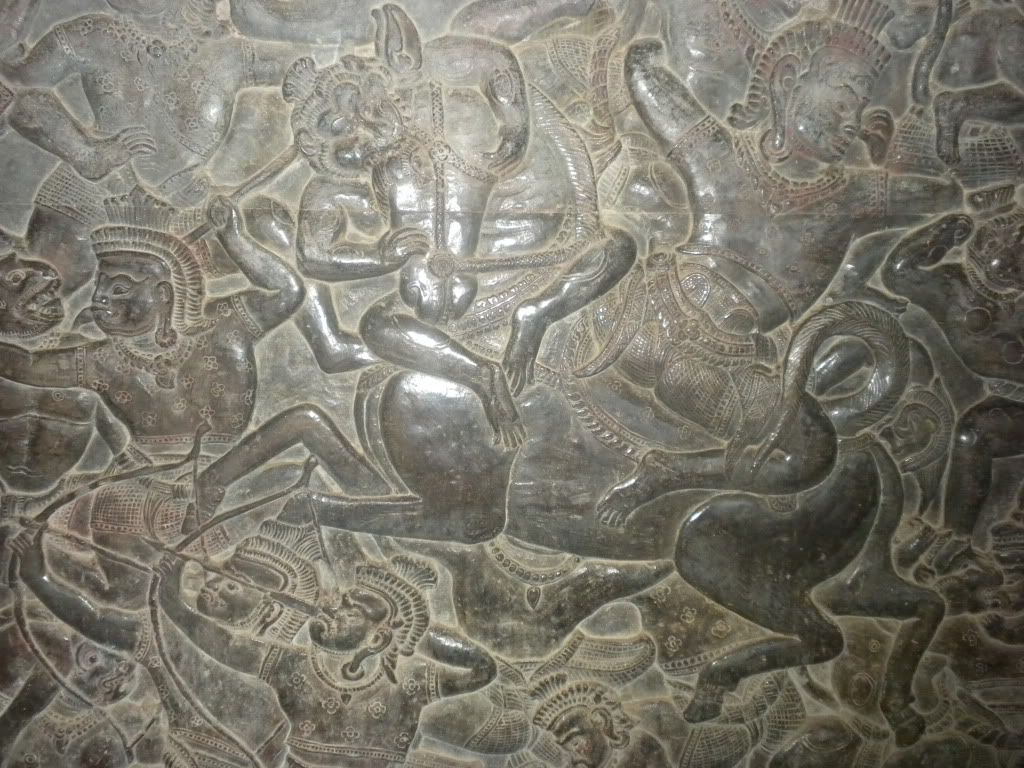
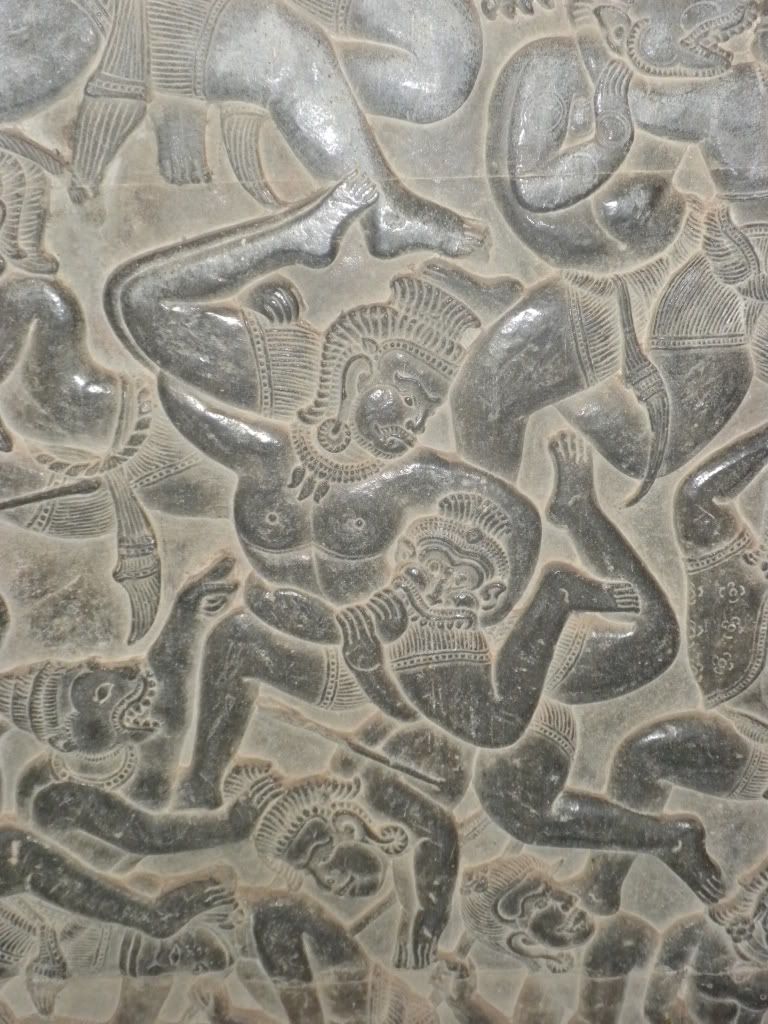
Passing the main entrance to Angkor Wat Francesca and I now found ourselves looking at the battle of Kuruksetra between the Kauravas (advancing from the left) and the Pandavas (from the right), depicting four divisions of the Mahabharata, one of the major Hindu epics. From the guide we bought: “The composition is in a single panel and lined along its base with a procession in which one can distinguish some musicians, some foot-soldiers leading warriors marching to combat and their chiefs carried by elephants or horse drawn chariots. It is only in the center that the struggle turns into a furious scrum where certain details – such as the wounded horse collapsing lanced with arrows - are treated with a striking realism.”
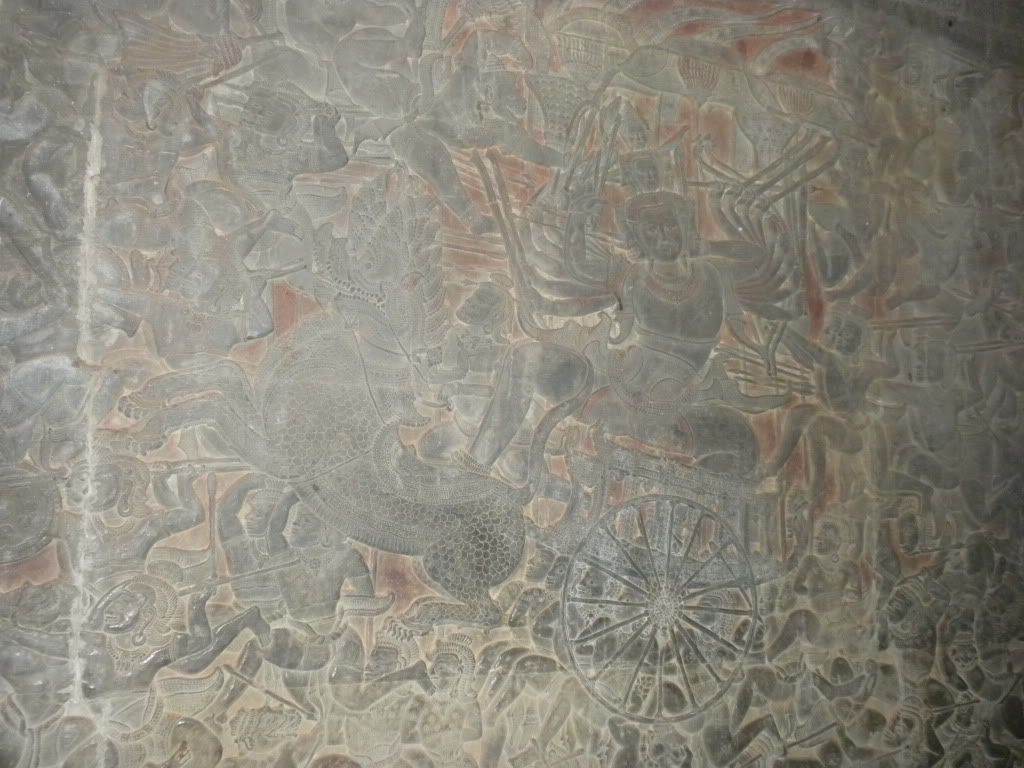

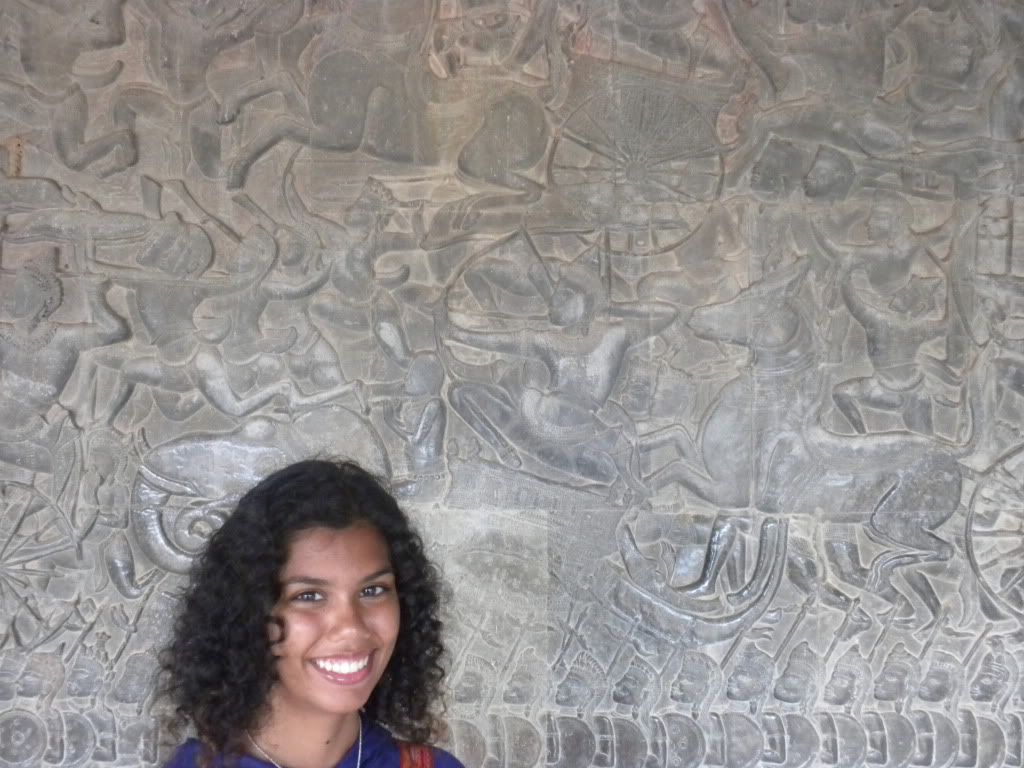
At the end of the gallery we turned left, rays of sunlight through some of the window decorations. The Western part of the South Gallery is considered the historical gallery, where a single panel of 90 meters in length is dedicated to king Suryavarman II. The carvings show a parade of the king himself, his generals and his army, his lackeys, religious followers and even some Siamese warriors. We were shocked to see the state some of the carvings were in. When Wanny explained most of the South Gallery had been devastated by American bombing, and a part of the carvings had been destroyed we both gasped a little. Luckily they had been able to put the pieces back together, the pockmarks of shrapnel still visible leaving a reminder of dark deeds by foreign intruders.
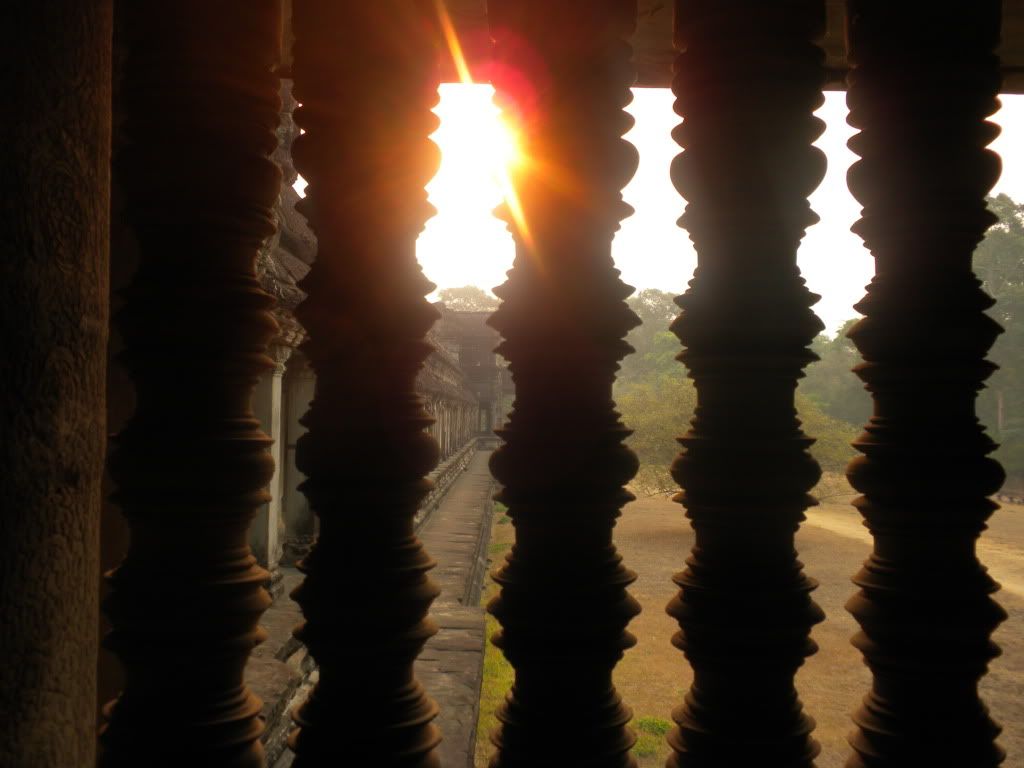
The second half of the gallery touched upon life and death. Wanny told us the carving had been divided into 3 parts: the top was ‘Heaven,’ the middle ‘Life,’ and the bottom portrayed ‘Hell.’ ‘Heaven’ and ‘Life’ looked similar and a little dull, but ‘Hell’ was extremely interesting. We saw Yama sitting on his buffalo, accompanied by his henchmen Dharma and Sitragupta. We also saw many carvings of the punishments they had dealt out: people who have damaged others’ property have their bones broke; the glutton is cleaved in two; rice thieves are afflicted with enormous bellies of hot iron; those who picked the flowers in the garden of Shiva have their heads pierced with nails, and thieves are exposed to cold discomfort. Perhaps a little disproportionate to the crimes committed…
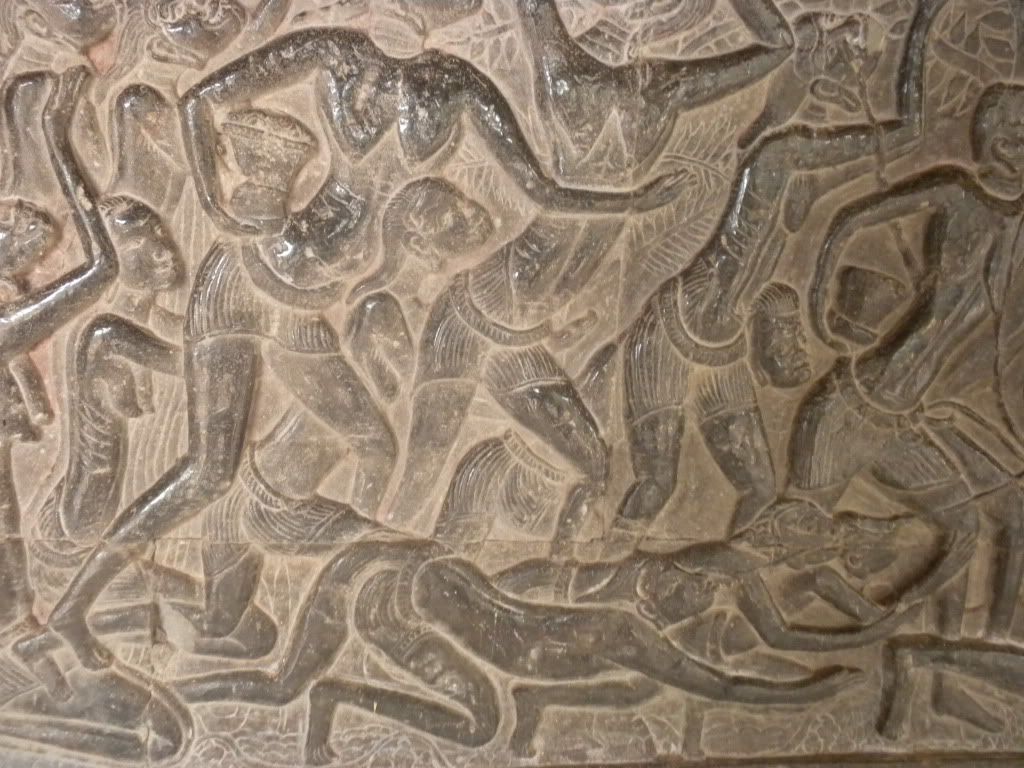
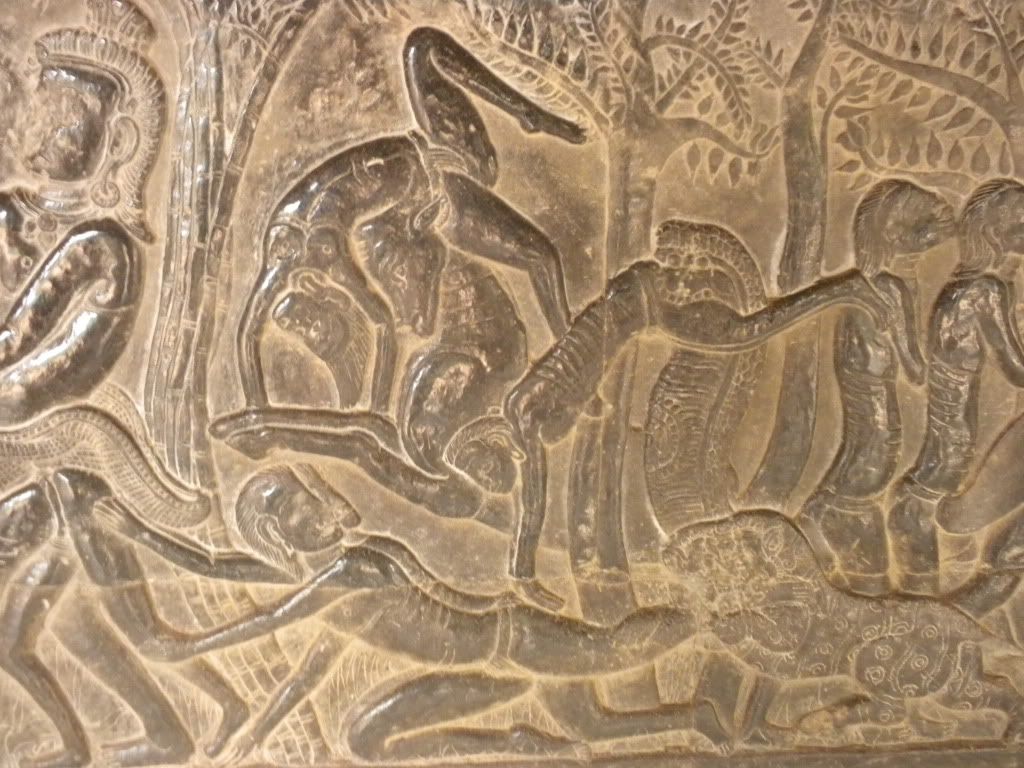
Turning the corner we reached the East Gallery, where Francesca’s favorite scene could be found: “The Churning of the Sea of Milk.” The Churning is the famous creation story of the Khmer. Before the earth existed there were devas (gods) and asuras (demons). Churning the milk under them would result in an elixir of immortality. The two sides naturally end up fighting and for over 1000 years they do battle. Eventually Vishnu gets them to work together and for another 1000 years they churn. The mount Mandara, a giant turtle and one of the incarnations of Vishnu, serves as a pivot while the cord is represented by a giant snake, Vasuki. Each side is helped by some larger figures such as Hanuman, the Monkey King from the Ramayana. After 1000 years the churning is finally over and the elixir is ready. The demons manage to grab the potion, only to be outsmarted by Vishnu who tricks them and keeps it safe from there on. Unfortunately the Gallery was under renovation and we couldn’t look at the carvings up close.
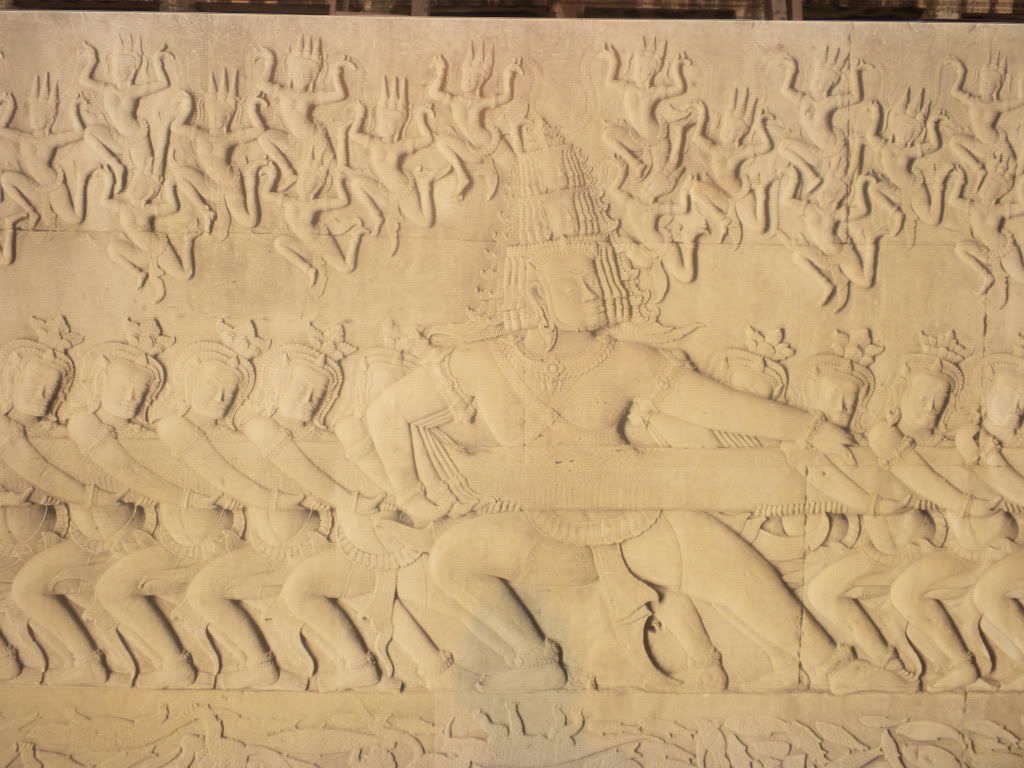
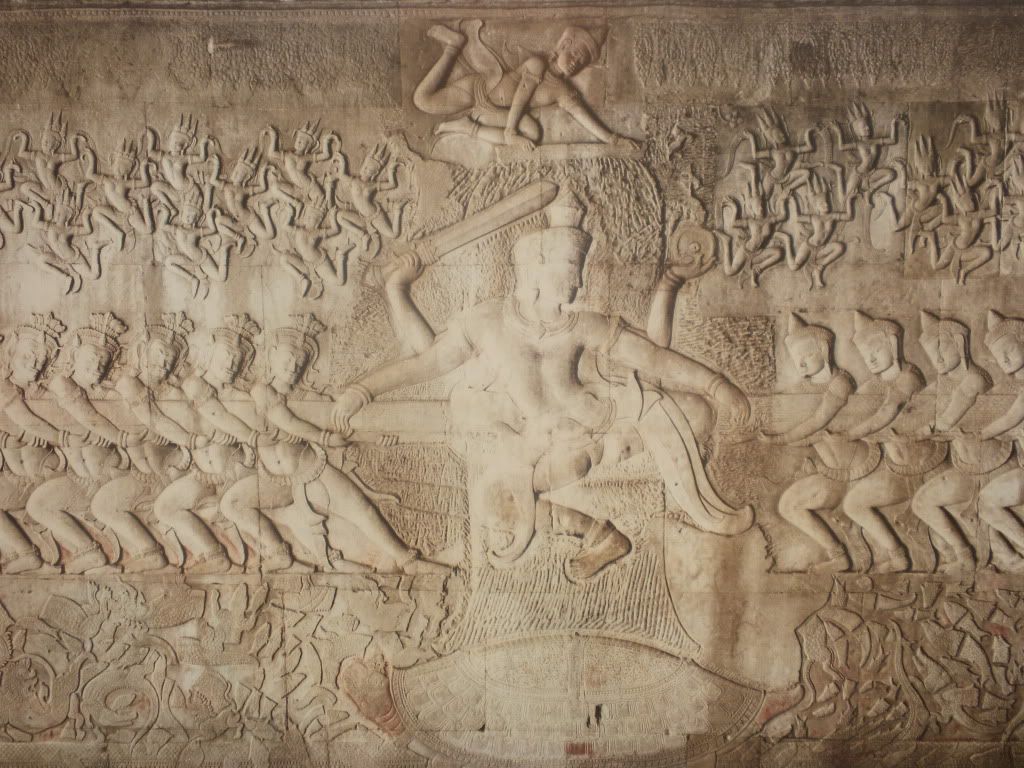
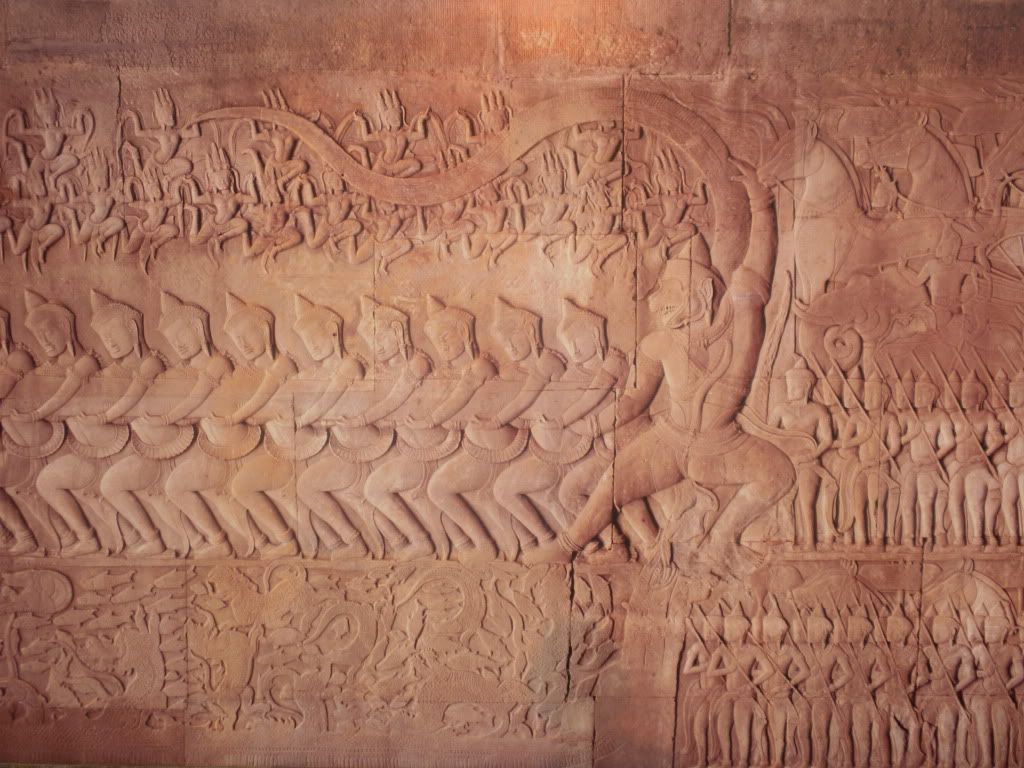
We were now at the back of the temple, where Wanny showed us the ‘Elephant Platform,’ a platform without a staircase, solely used for climbing on or off of elephants. We finally had a good look at three of the five center towers, which looked even more impressive in daylight. Wanny explained they were designed to look like closed lily buds. Wanny took us inside to the first enclosure, whilst Francesca walked ahead and posed for me on the staircase and in the windows. We continued and exited the first enclosure.
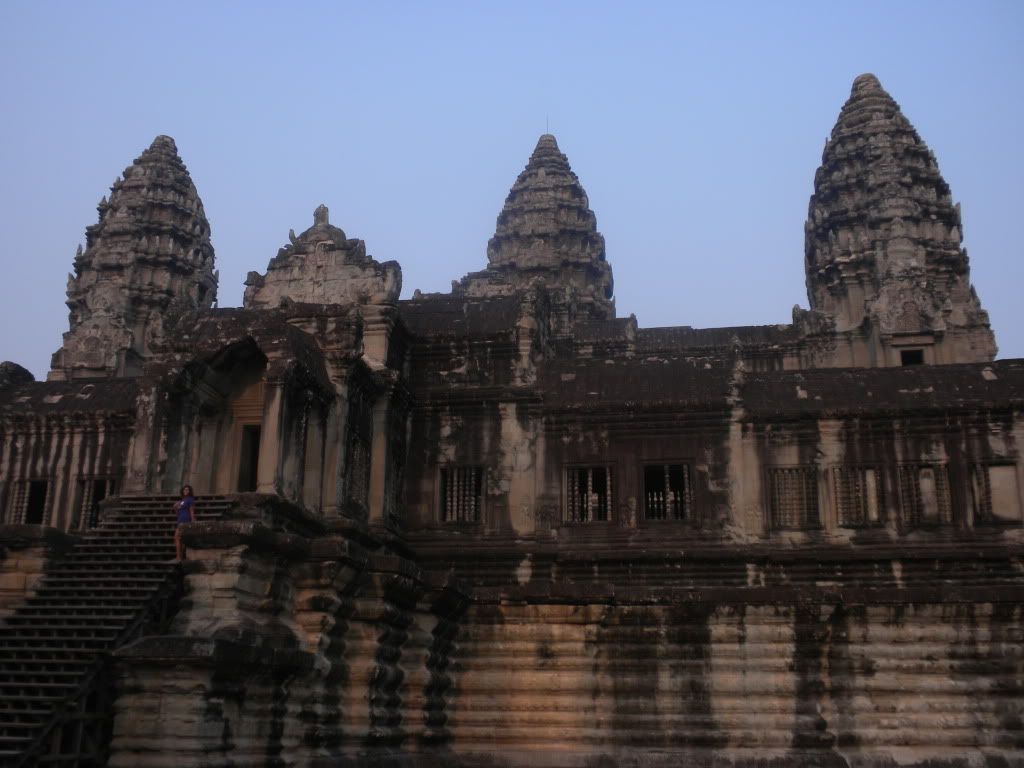
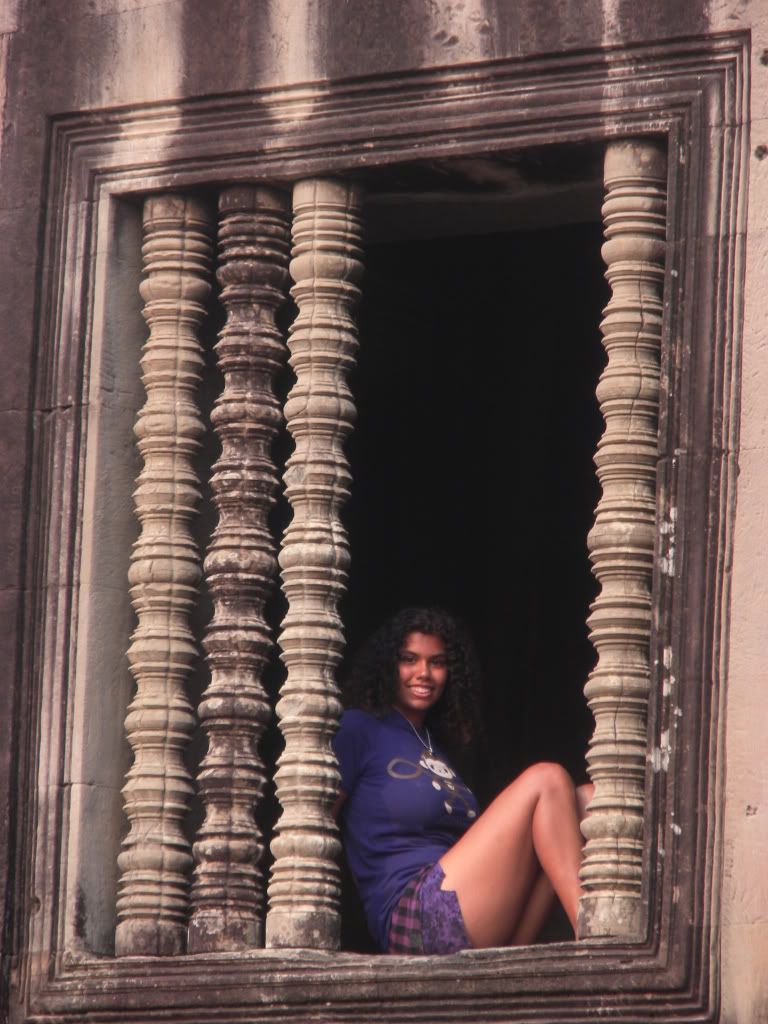
This left us gazing at the ‘Bakan,’ the central tower of Angkor Wat. Wanny took us around the central enclosure, showing us many ‘Apsaras.’ As I explained in a previous post, ‘Apsaras’ are the court dancers of the Khmer. The women go through rigorous training from an early age, devoting their life to the thousands of techniques they had to learn. We sat down to wait for the staircase to the ‘Bakan’ to open. Whilst we waited a friend of Wanny’s with his group came by. They were all locals and were quite bewildered by my freckles. A group of monks passed by, climbing the stairs to the ‘Bakan.’ We wondered why they were allowed up. Wanny went to ask what was going on and found out it was a public holiday, which meant the terrace was reserved for locals and monks.
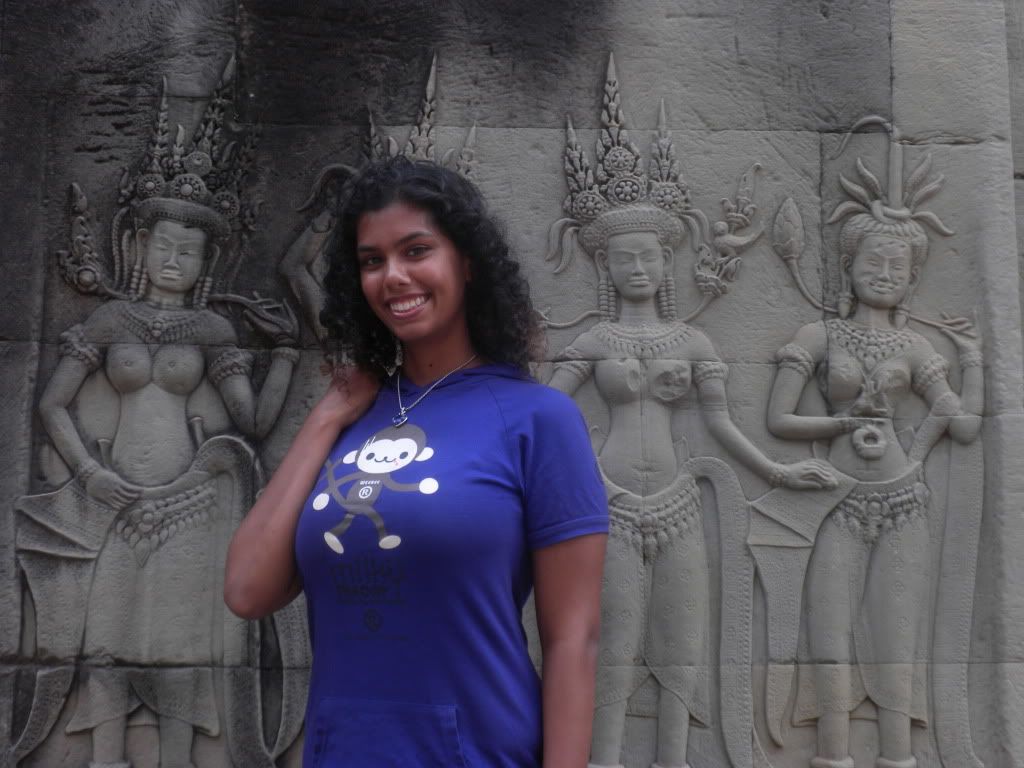
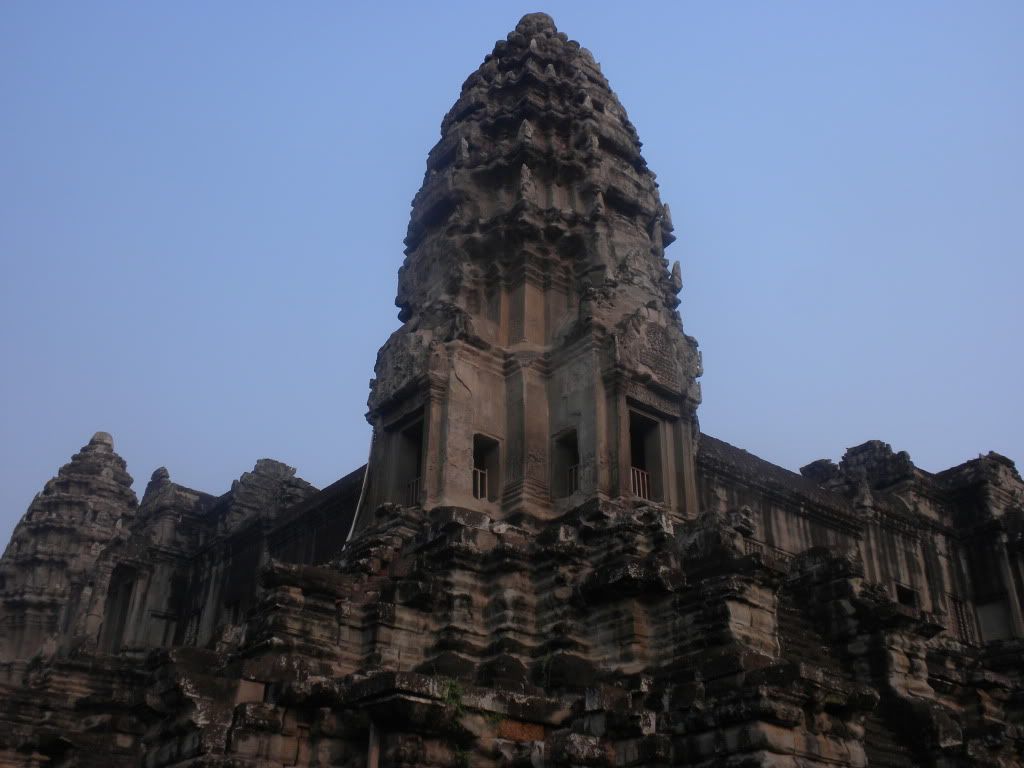
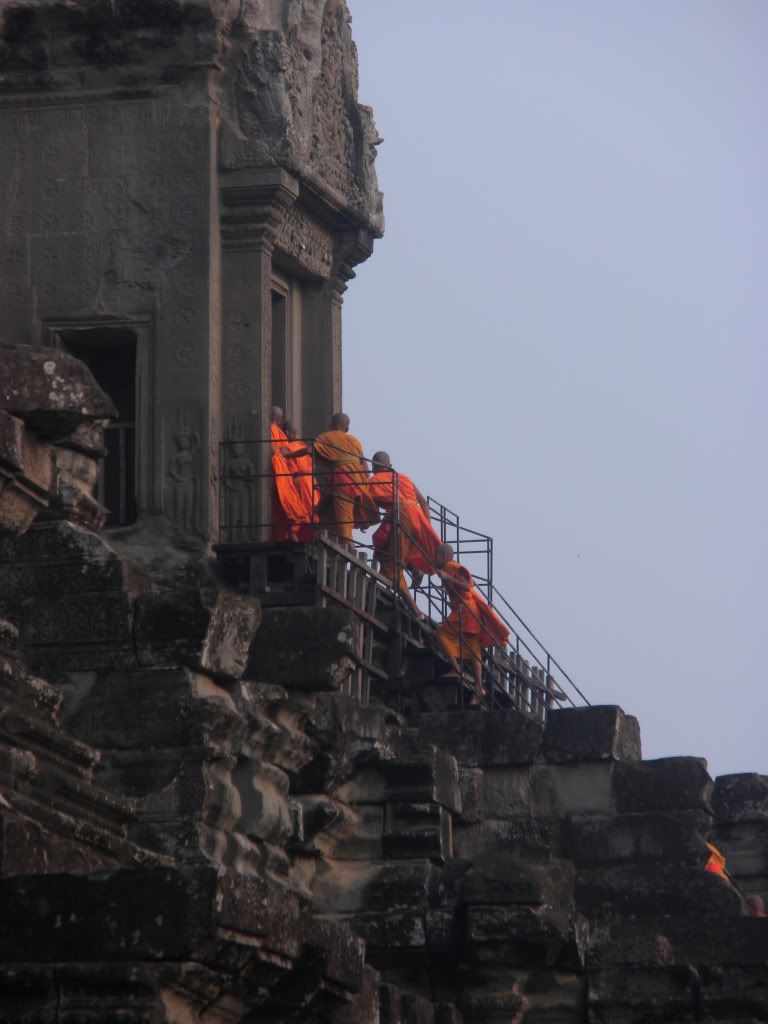
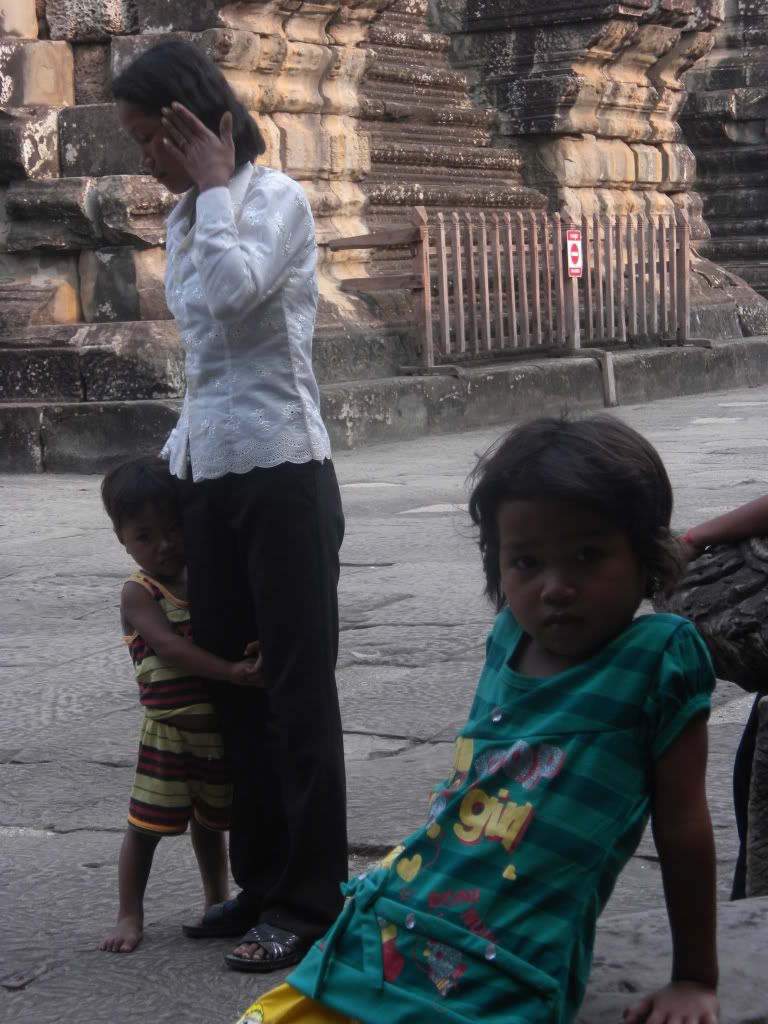
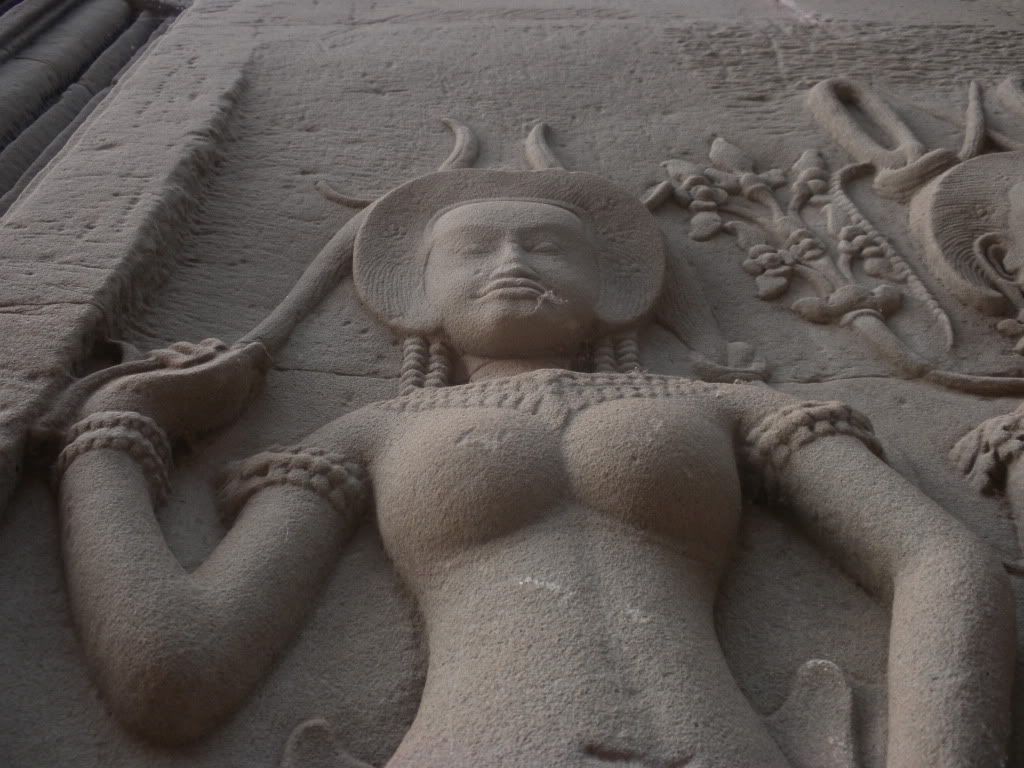
Francesca and I decided we would come back another day and followed Wanny to the front of the ‘Bakan.’ We were shown two staircases leading up the ‘Bakan,’ both closed off. The first one was extremely steep and looked very dangerous. In fact, several tourists lost their lives tumbling down on their way back. Therefore it was closed off and now you can only use a wooden staircase set up on the East side. The West side’s stairs looked much more climbable. This one connects directly to the causeways and has much wider steps and less of an incline. Makes sense, since it was reserved for the king.
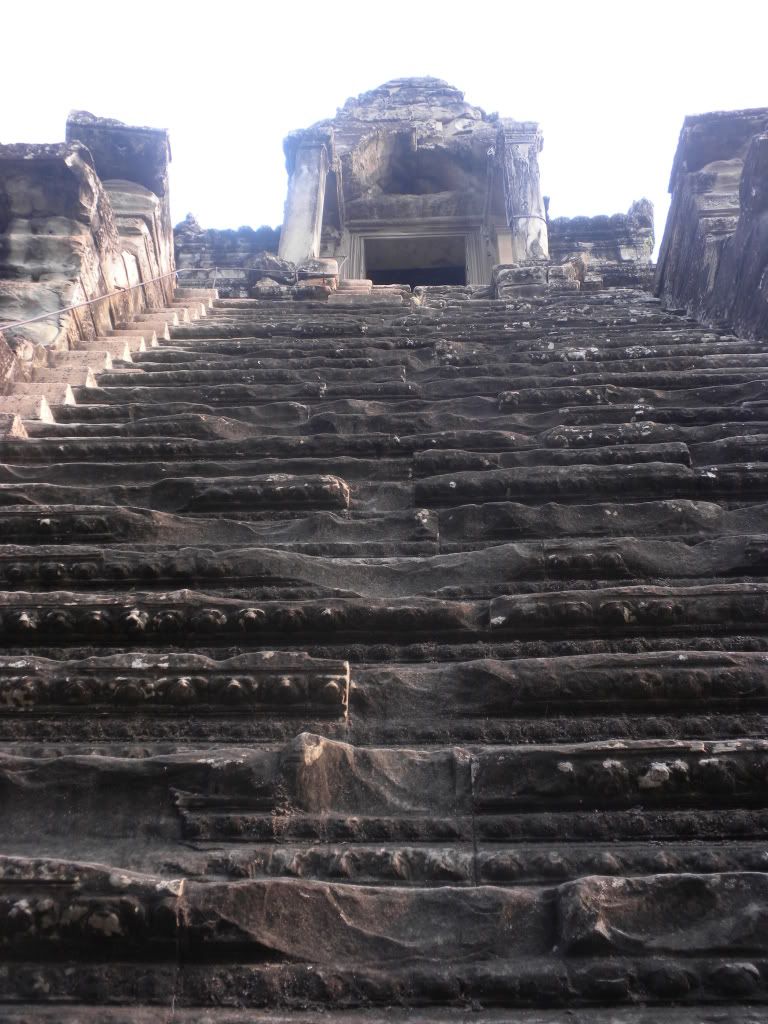
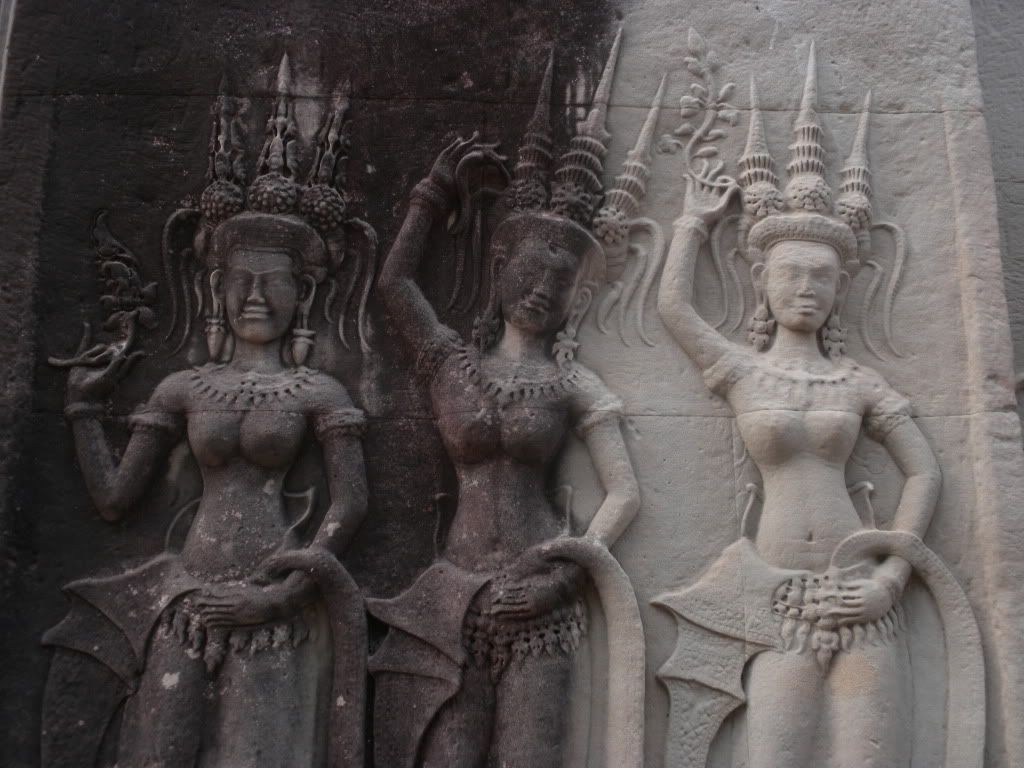
We exited the central enclosure, once again entering the first enclosure. Wanny showed us several pillars inscribed in Old-Khmer. Wanny couldn’t tell us what they said exactly, but it was amazing to see we could still read it (if only we could read Khmer) after this many centuries. Otherwise not too interesting, resulting in our departure from Angkor Wat. Back on the causeway we got a mandatory picture of the two of us with Angkor Wat. We had a look at the Vishnu statue in the gopura, observing the deity holding representations of the four elements in his hands: a lotus (water), mace (earth), conch shell (water) and chakra (wheel) (fire).
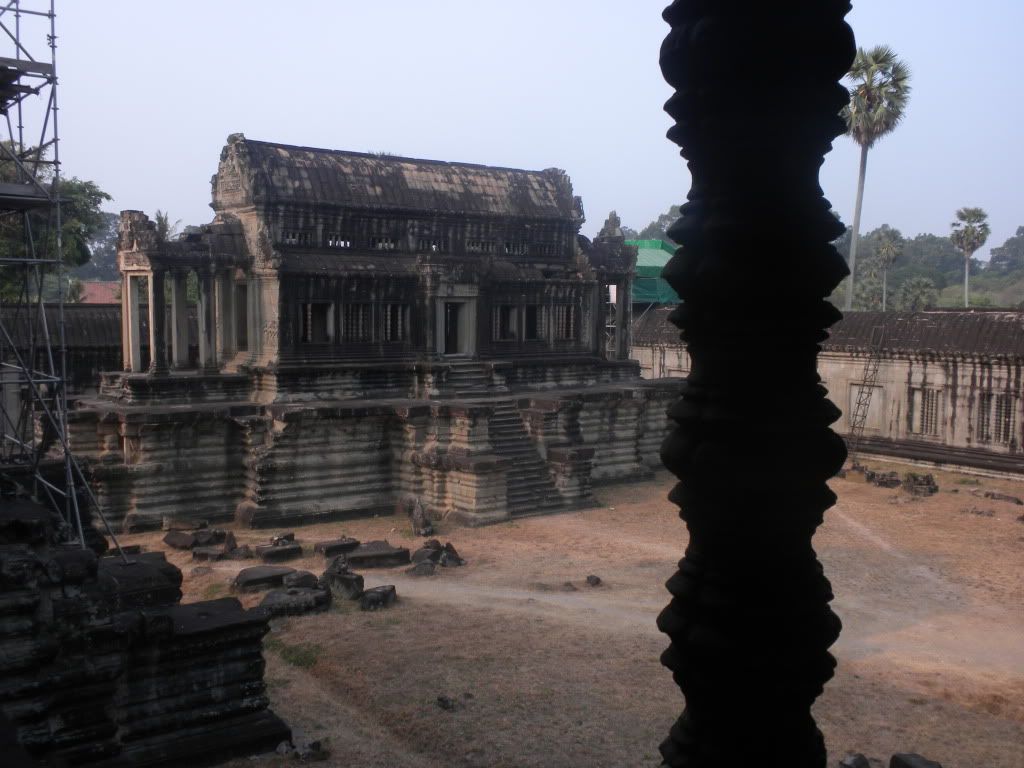
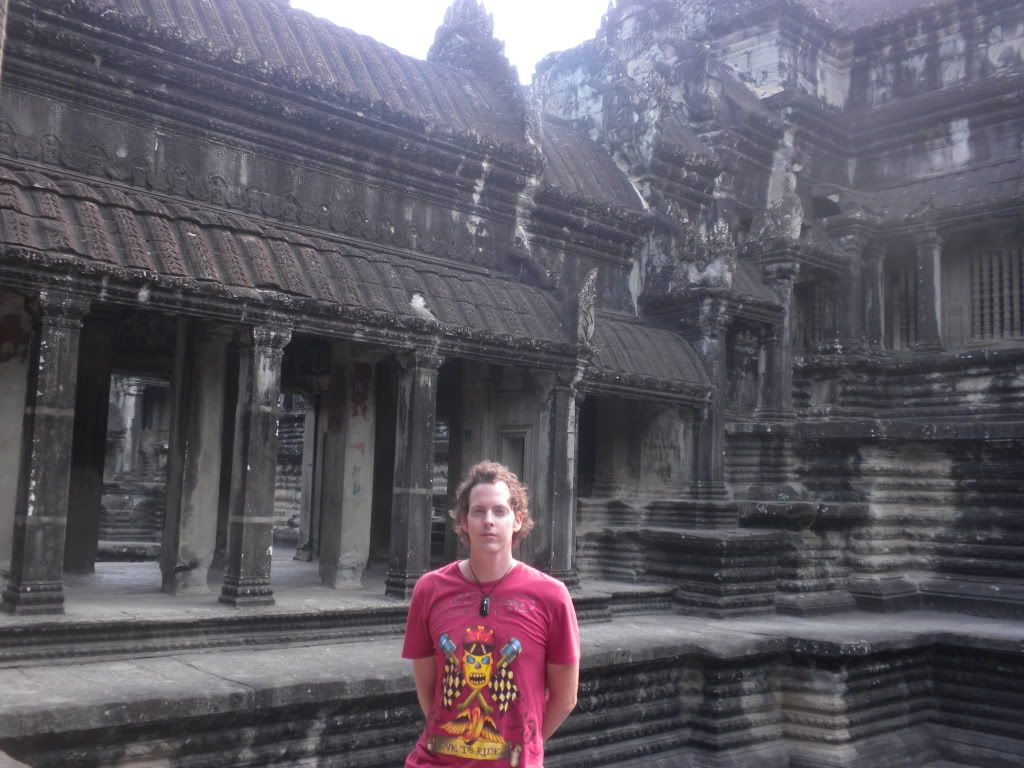
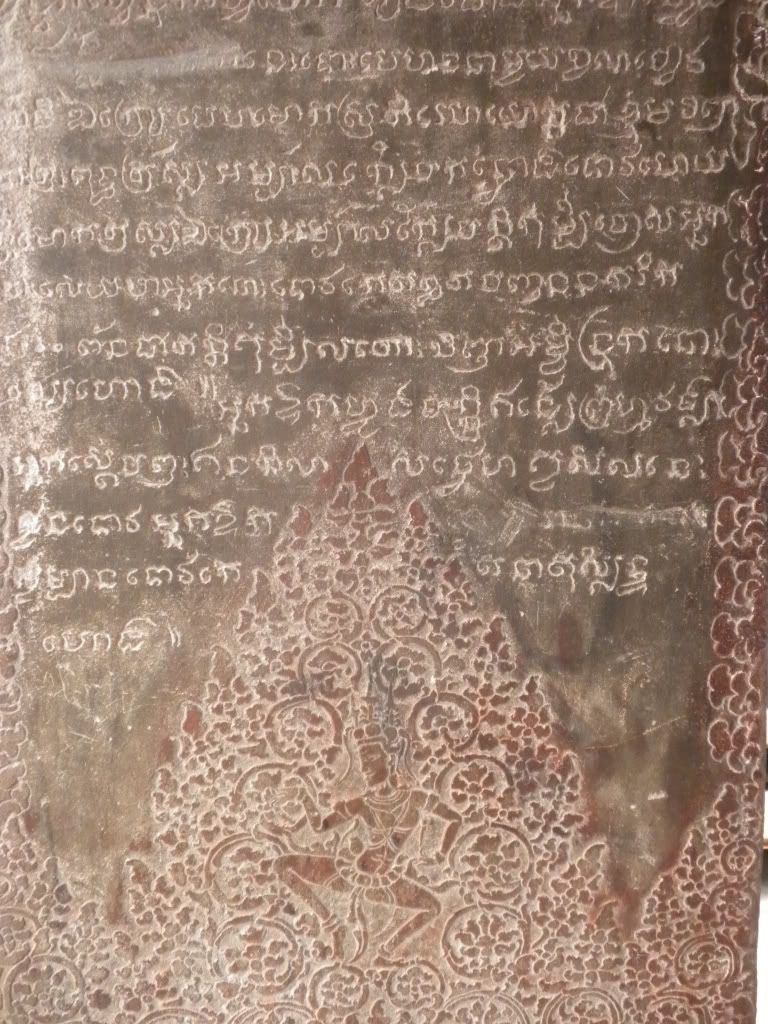
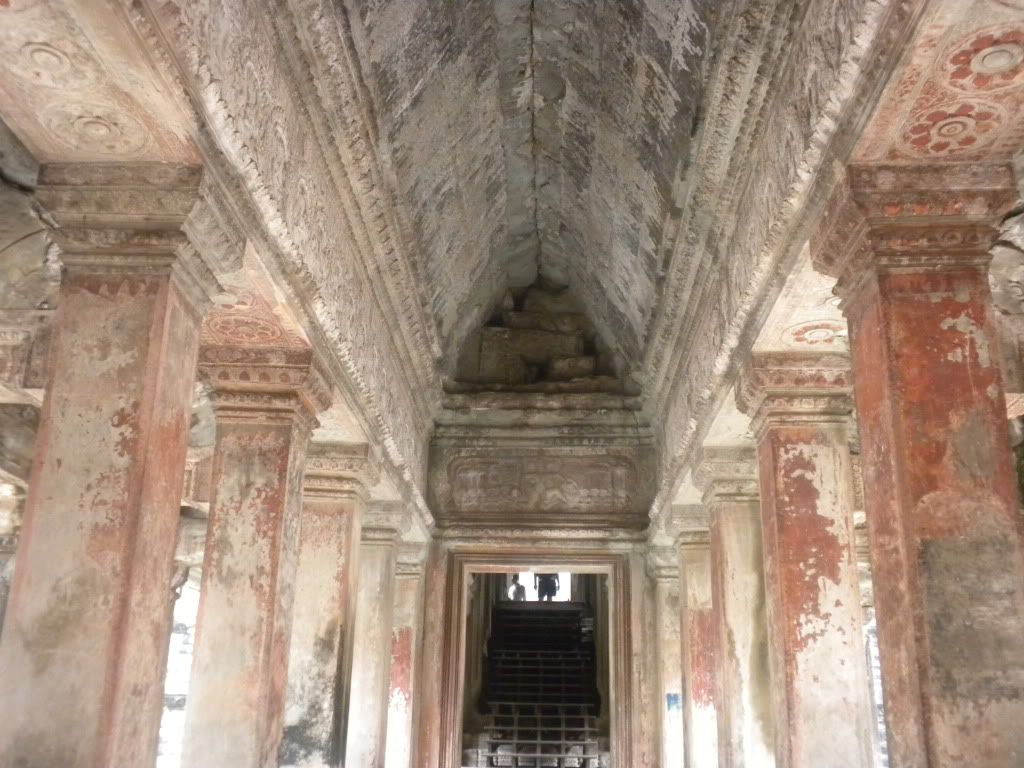
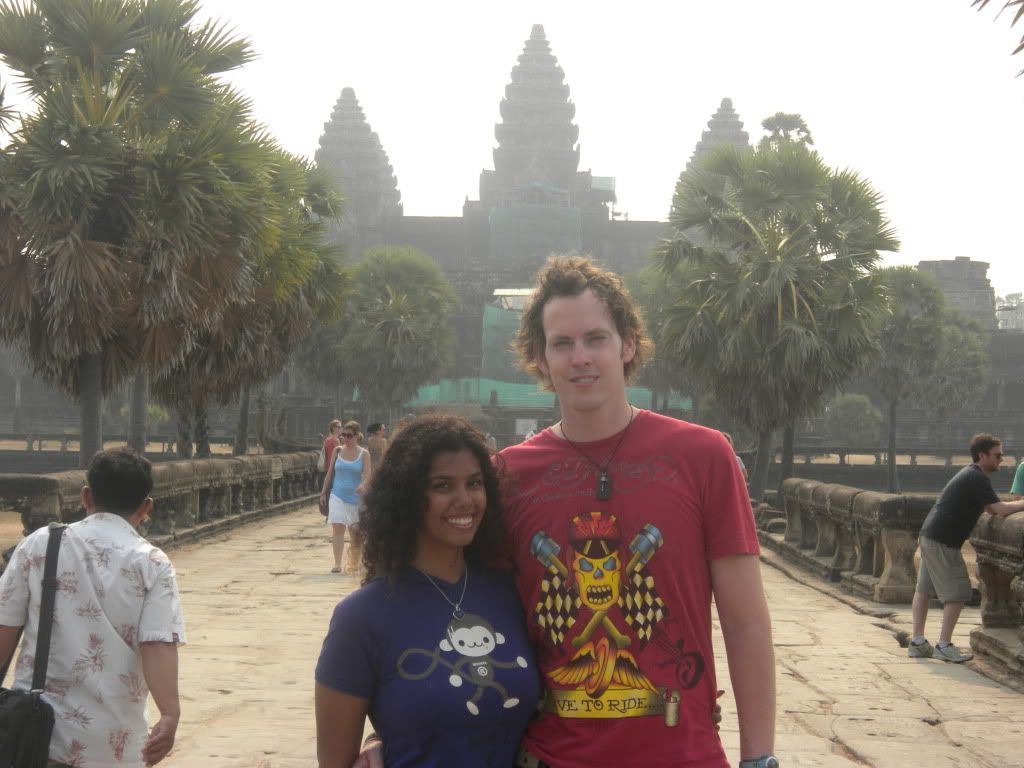

The tuk-tuk driver then took us to the West gate of Angkor Thom, the late capital of the Kingdom. Angkor Thom ("Great City") was the last and most enduring capital city of the Khmer empire. It was established in the late twelfth century by king Jayavarman VII. It covers an area of 9 km², within which are located several monuments from earlier eras as well as those established by Jayavarman and his successors.
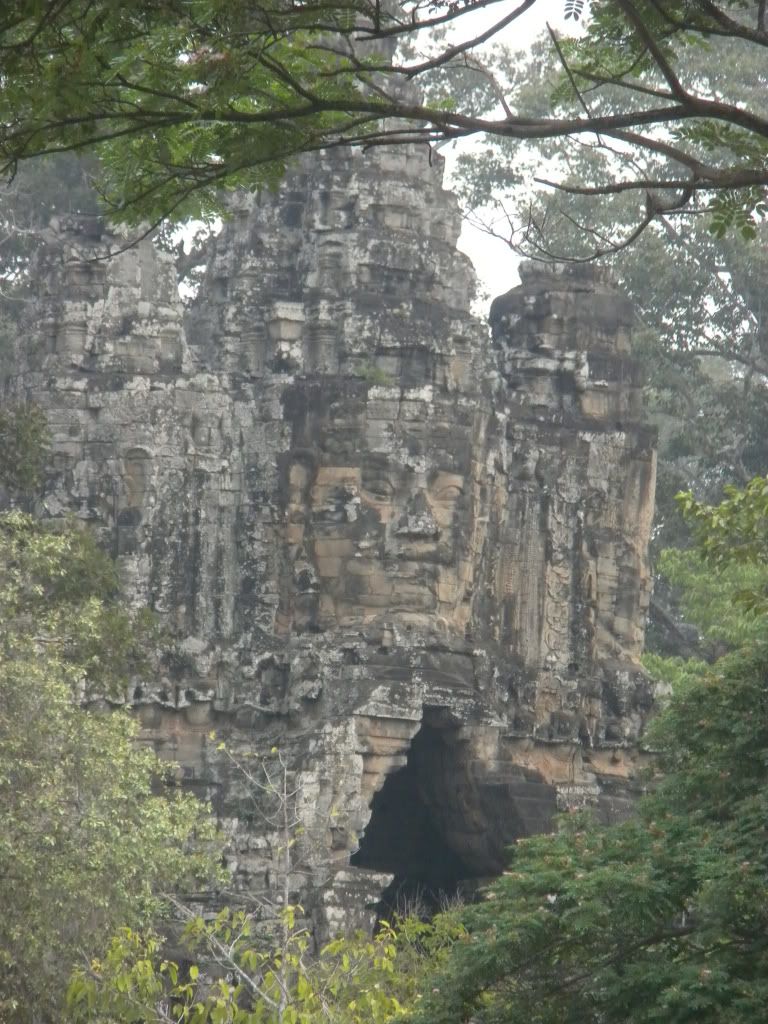
The first monument we got to was, as I said, the West gate. The gate was preceded by another ‘Churning’ on each side of the road. Unfortunately most of the heads were no longer original. Looters took them in the previous century, eager to make a quick buck selling the heads to foreign collectors. The combination of the ancient stone bodies with the newer and shinier heads was bizarre to see. We walked through the gate and had a good look at the giant stone face that looked back down at us. I had seen some pictures of the faces before, and seeing them in real life was stunning. On the other side of the gate we saw Indra sitting on her three-headed elephant. The gate was quite ruined and some of the elephant’s trunks were gone.
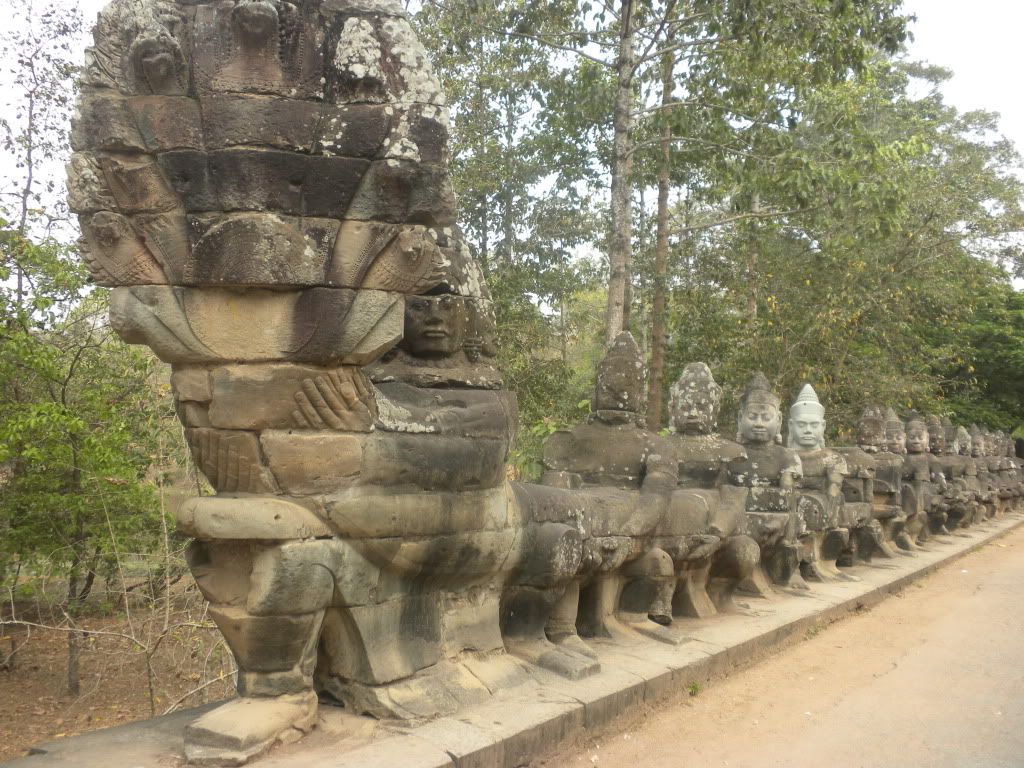
The tuk-tuk stopped just a few minutes later and we walked towards my favorite temple of them all: the Bayon. Built in the late 12th century or early 13th century as the official state temple of King Jayavarman VII, the Bayon stands at the center of Jayavarman's capital, Angkor Thom. Jayavarman VII was different from the previous Khmer rulers because he was a Mahayana Buddhist, whereas previous Kings had always been Hindus.
We walked towards the entrance to the Bayon. Before we had a look at the towers Wanny took us around the base of the temple, pointing out all the reliefs on the walls and telling their story to us. We first had a look at the Eastern gallery where we saw the Khmer do battle against the Cham: “In a large deployment, Cham and Khmer forces are in battle, forming a furious melee towards the centre with the elephants themselves also taking part in the action. One of them tries, with his coiled trunk, to pull a tusk from another who opposes him. Another is unusually represented from the front. Countless standards, banners and sunshades form a veritable back-cloth - and one can see, on the side of the Khmer who seem finally to dominate, some curious grilled panels that were perhaps designed to stop the arrows from the adversary without obscuring the view.”
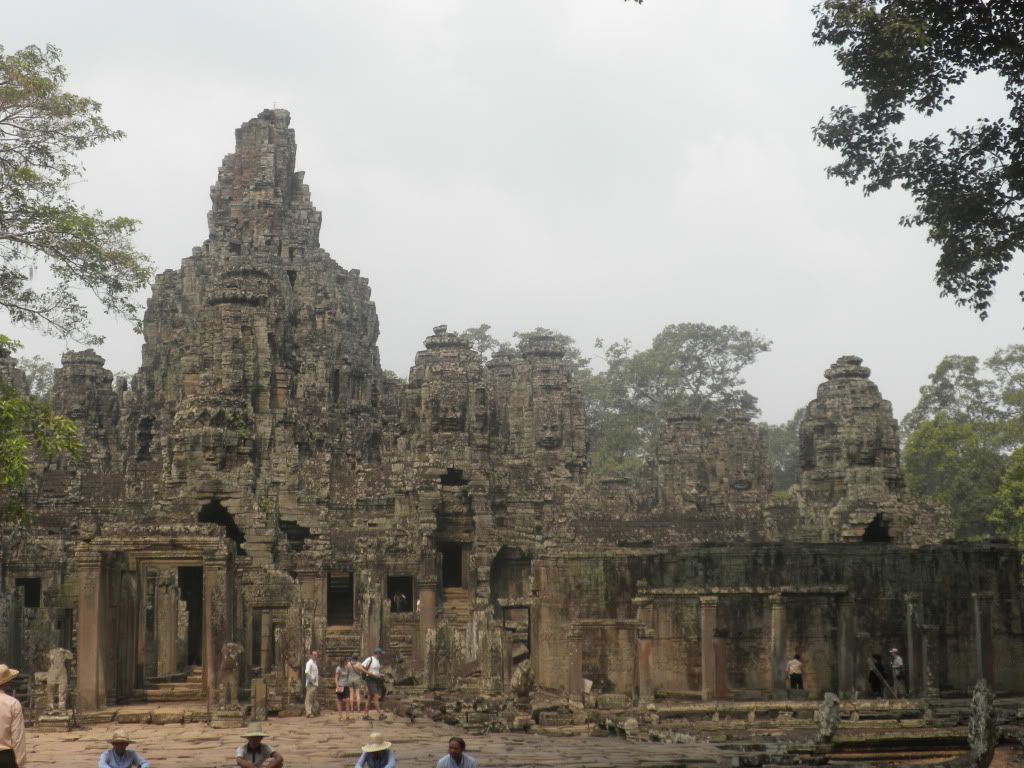
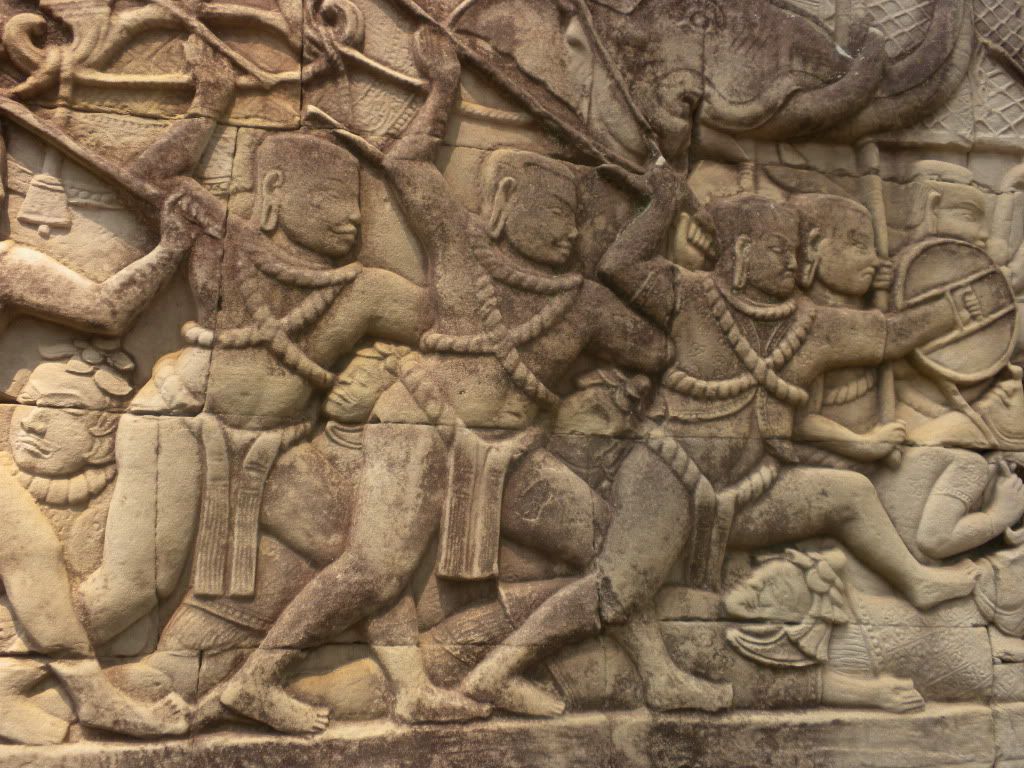
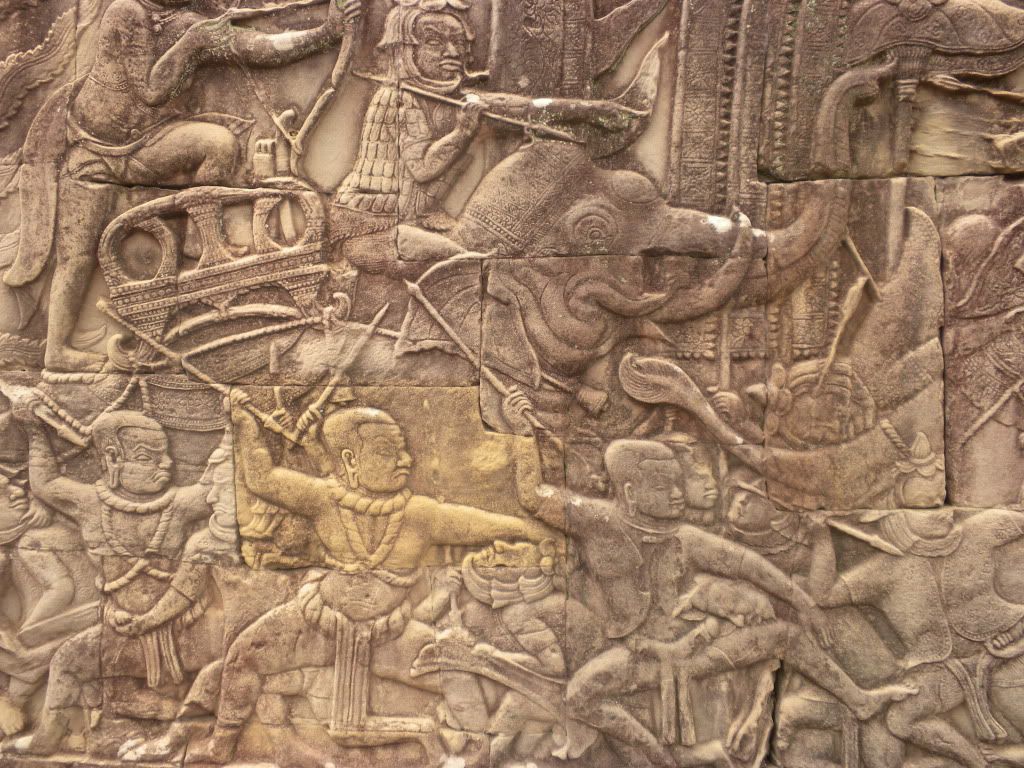
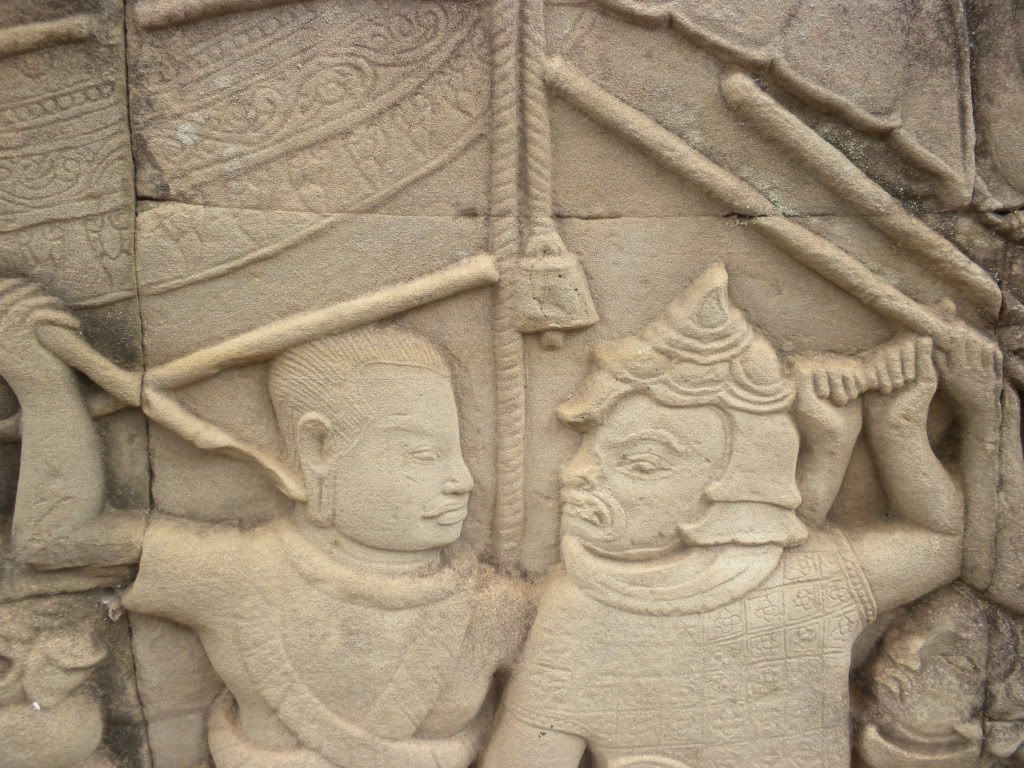
The other half of the Eastern gallery showed scenes of the daily life in Angkor Thom, including carvings of Chinese inhabitants drinking alcohol, other locals washing clothes and making dinner. We turned the corner to the South gallery, which showed, as our guidebook explained, the “naval combat that took place in the last quarter of the 12th century between the Khmer (whose hair is cut short) and the Chams (coiffed with a sort of upturned lotus flower). It shows a conflict of battleships with richly ornate prows – like galleys – where the line of oarsmen’s heads is dominated by warriors armed with javelins, bows and shields. Bodies are thrown overboard, some to be devoured by crocodiles.”
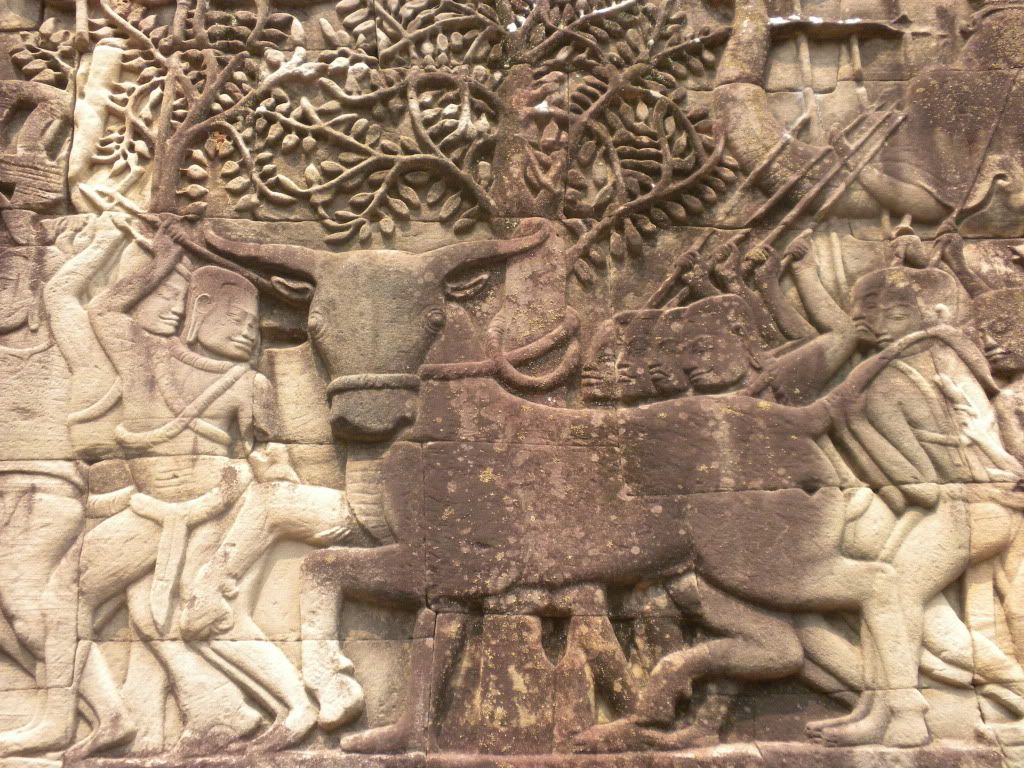
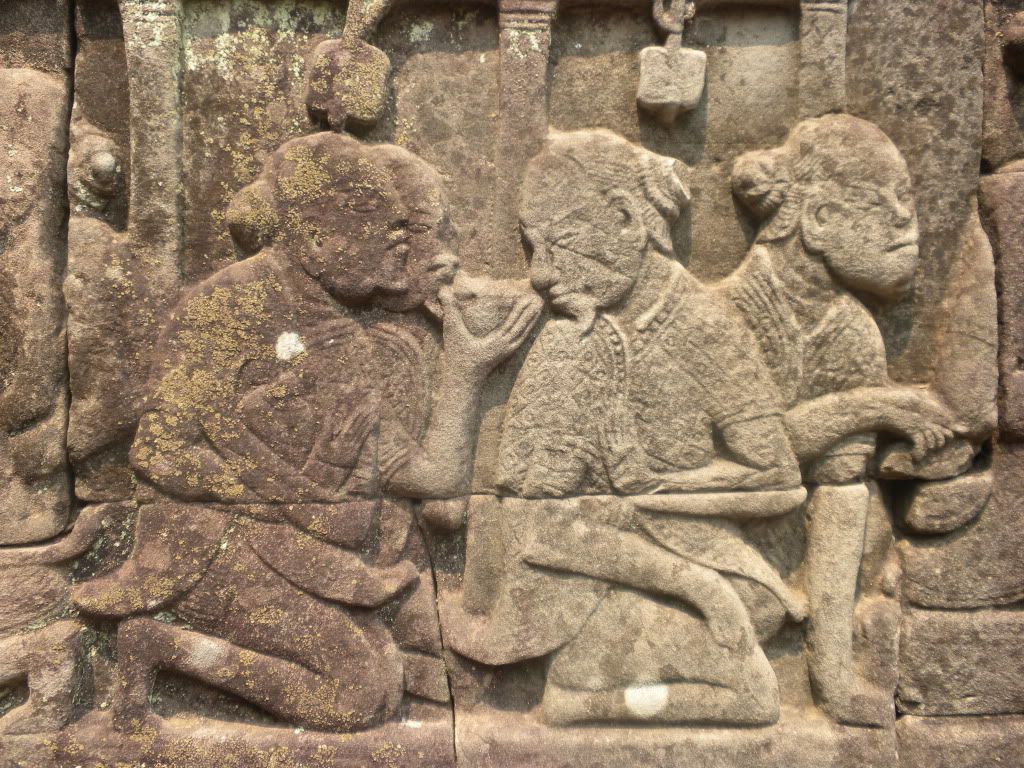
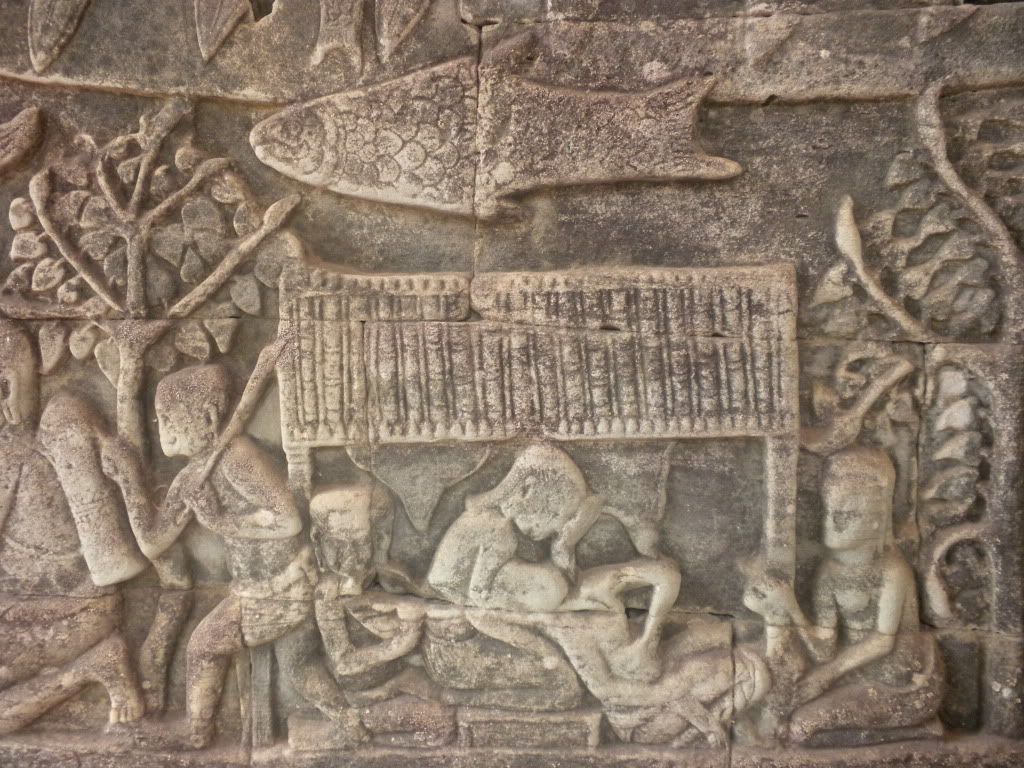
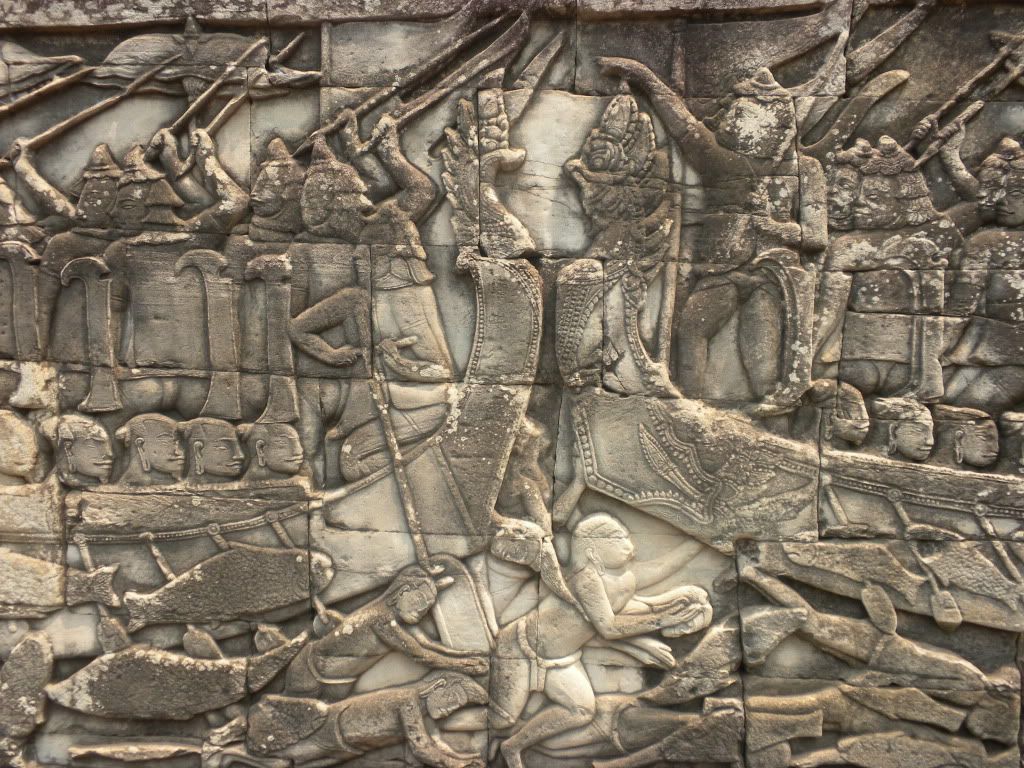
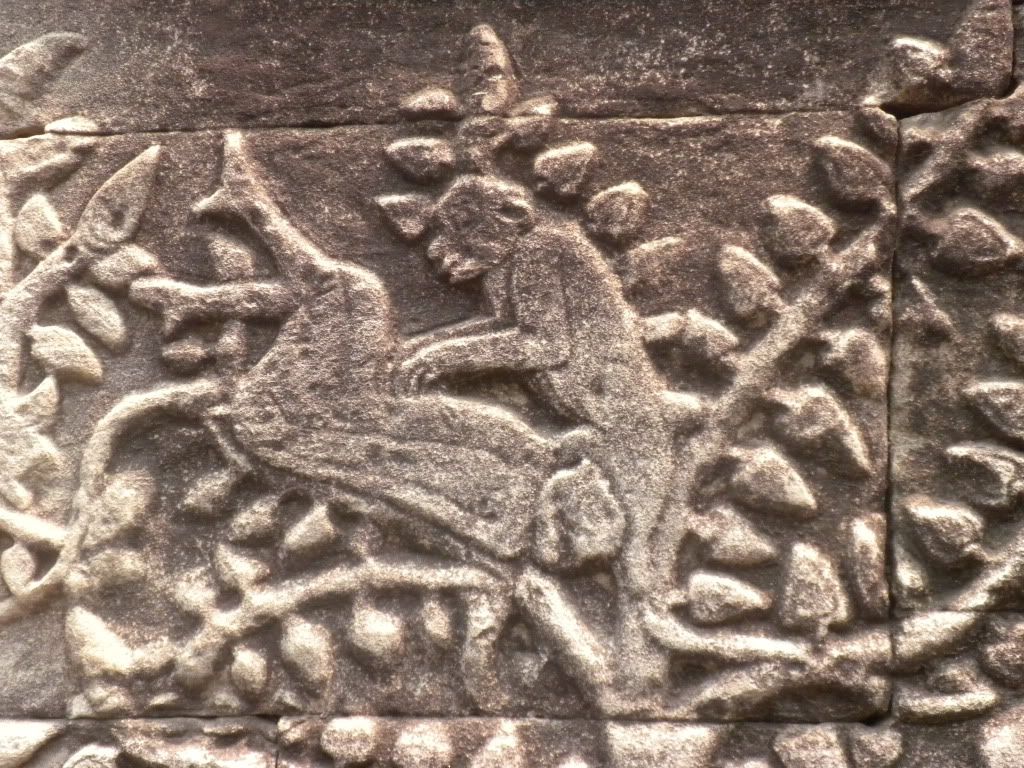
Climbing the stairs up to the main level of the Bayon we were suddenly surrounded by many gigantic faces leering down at us. The Bayon used to have 49 towers, each with 4 faces. Now 37 towers remain, leaving approximately 200 faces, but since some are only partially preserved there can be no definitive count. Even though researchers still debate about who the face represents, it is now generally agreed upon that it is a combination of Jayavarman VII and Buddha. Francesca and I walked around for quite some time, absorbing the smiles all around us and taking many pictures of the faces, sometimes incorporating ourselves.
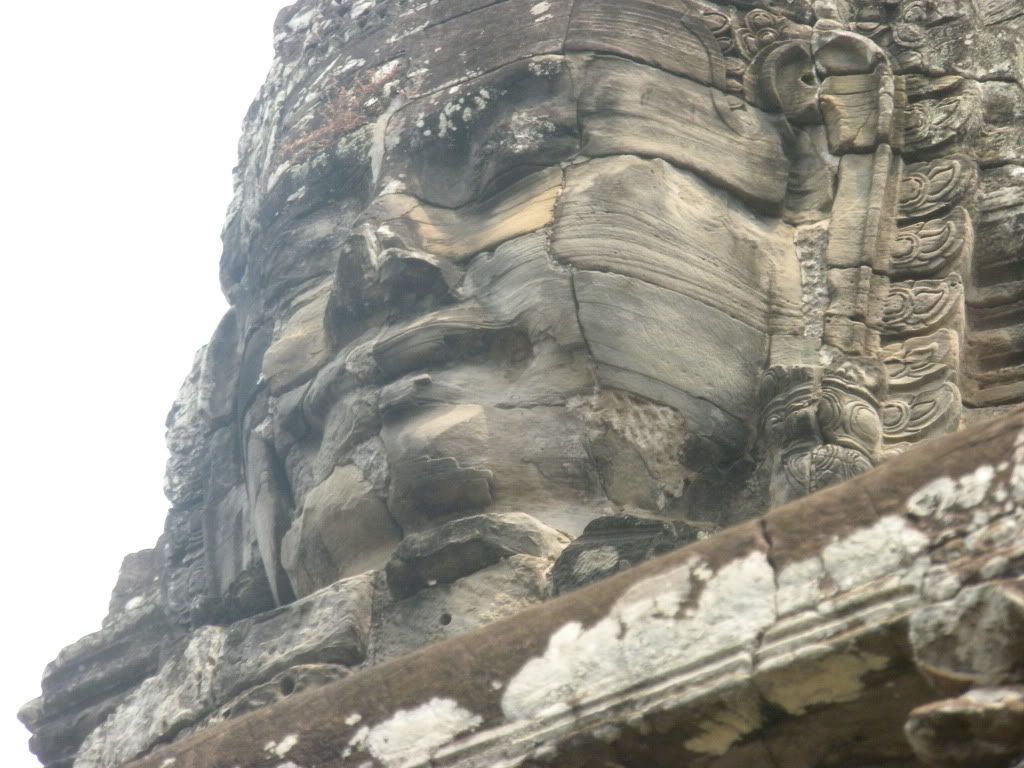
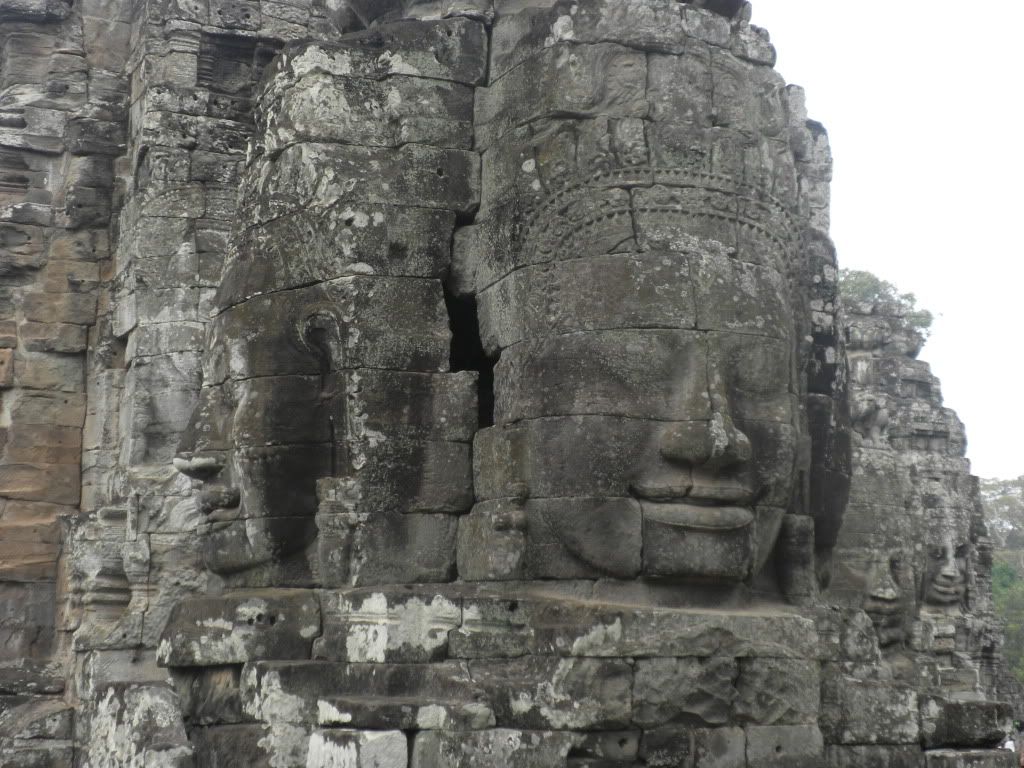
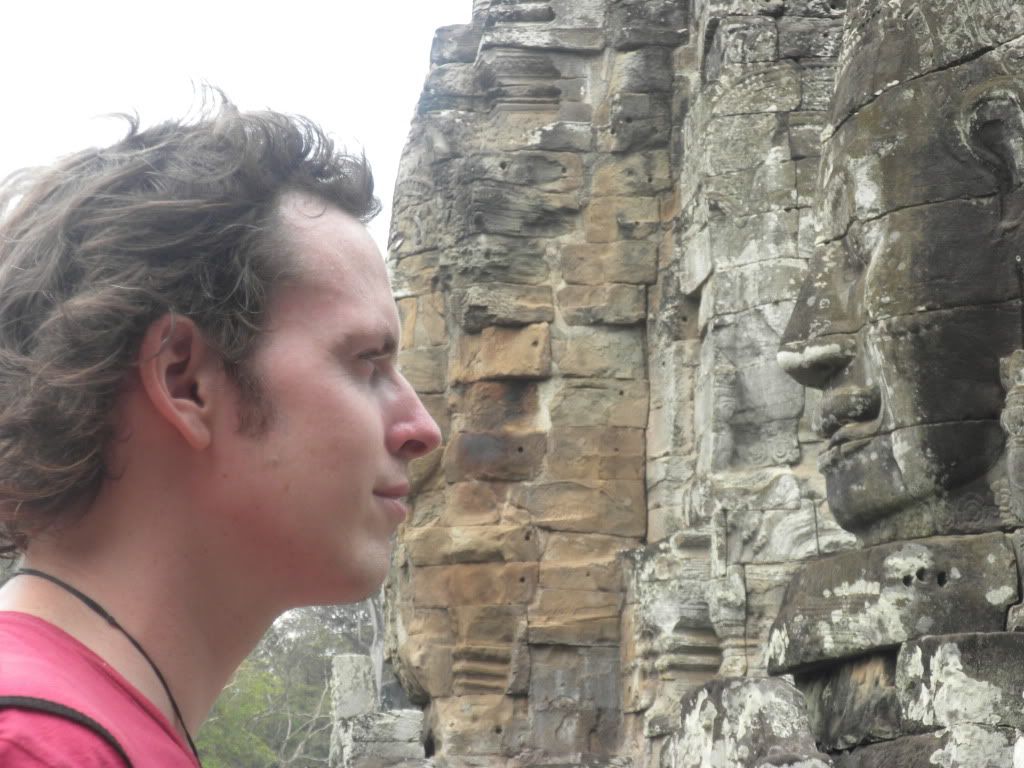
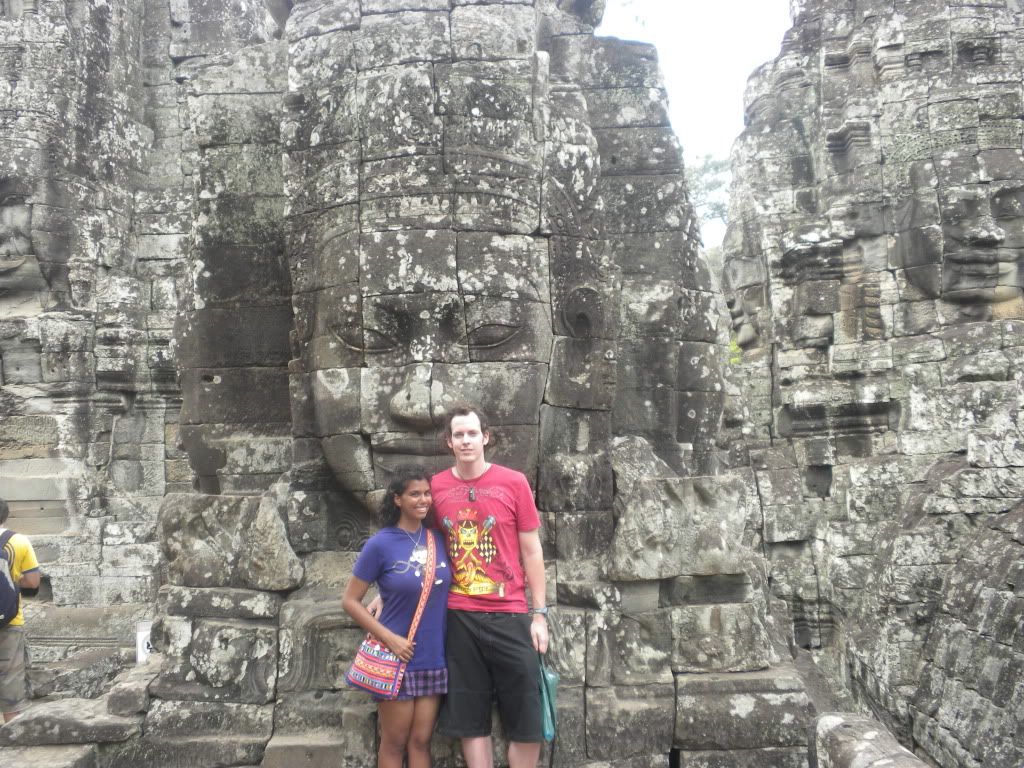
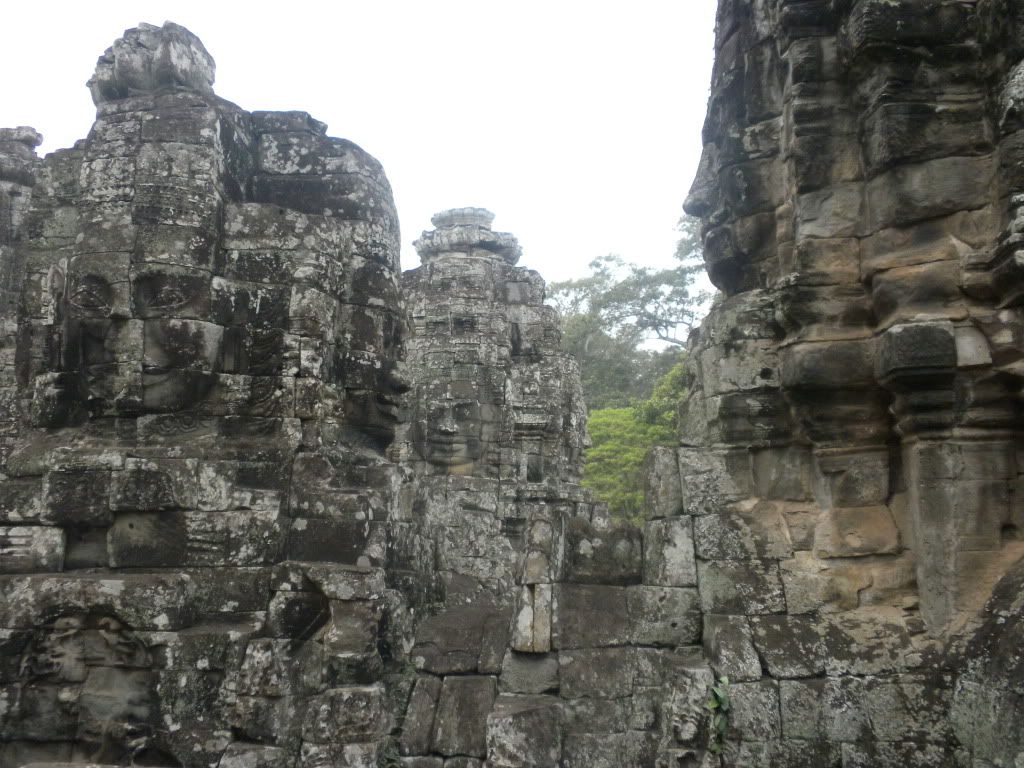
Around 11:00 AM we drove past the Terrace of the Elephants and the Terrace of the Leper King. We started on the former, later walking over it towards the latter. Wiki explains: “The 350m-long Terrace of Elephants was used as a giant reviewing stand for public ceremonies and served as a base for the king's grand audience hall. The terrace was used by Angkor's king Jayavarman VII as a platform from which to view his victorious returning army. Most of the original structure was made of organic material and has long since disappeared. Most of what remains are the foundation platforms of the complex. The terrace is named for the carvings of elephants on its eastern face.”
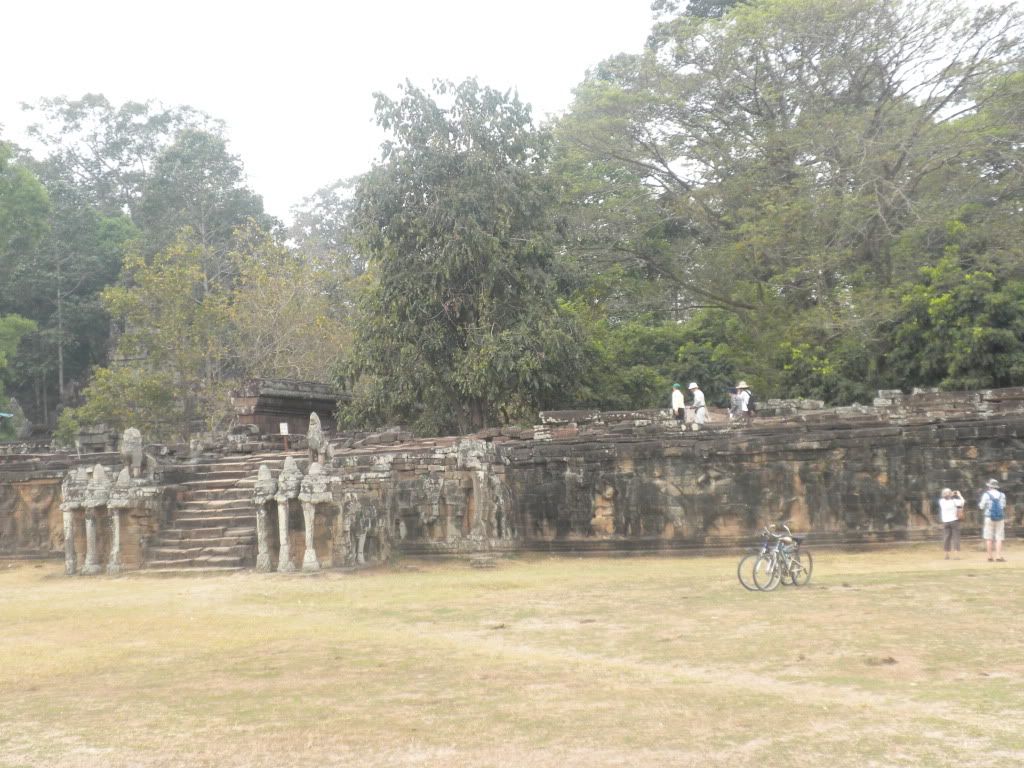
Connected to the Terrace of the Elephants we walked over to the Phimeanakas (“celestial temple”) “built at the end of the 10th century, during the reign of Rajendravarman (from 941-968), then rebuilt by Suryavarman II in the shape of a three tier pyramid as a Hindu temple. On top of the pyramid there was a tower. According to legend, the king spent the first watch of every night with a Naga girl in the tower, during that time, not even the queen was permitted to intrude. Only in the second watch the king returned to his palace with the queen. If the naga who was the supreme land owner of Khmer land did not show up for a night, the king's day would be numbered, if the king did not show up, calamity would strike his land.” Thanks again Wiki.
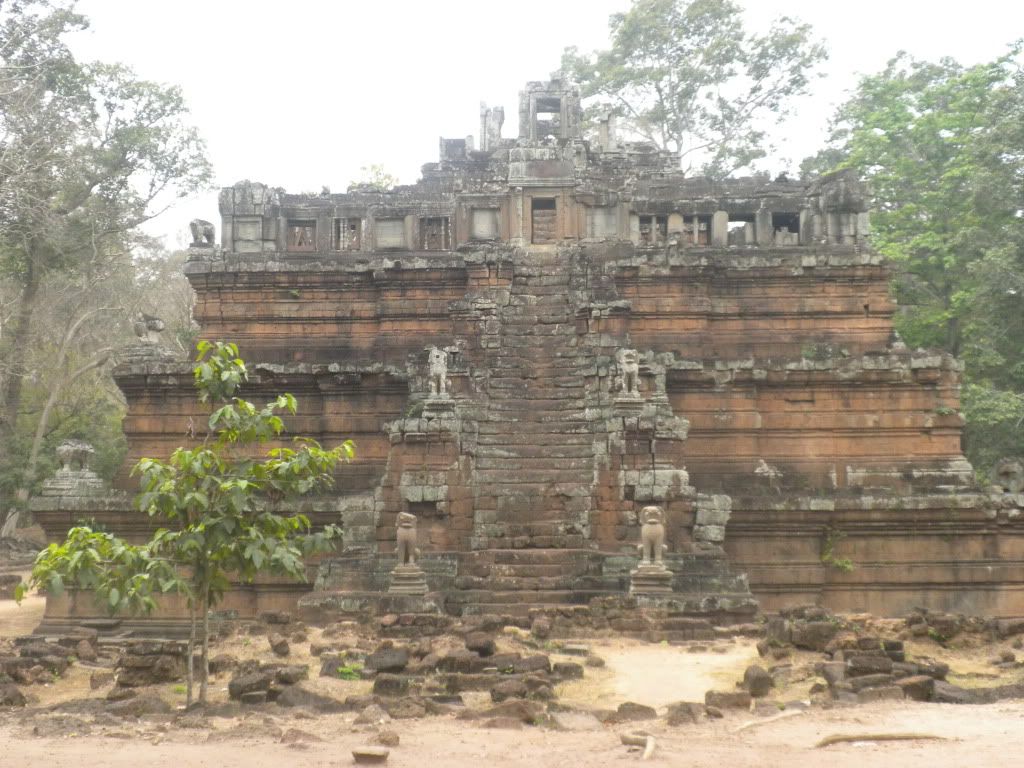
We walked back to the Terraces, picking up some small pineapples on the way and walking over to the Terrace of the Leper King. I loved the name, but the Terrace wasn’t extremely special. The Terrace was built under Jayavarman VII. Wanny told us why the Terrace carried such a cool name: In the 15th century researchers found a statue of the God of Death, Yama. He was called the Leper King because discoloration and moss growing on the original statue was reminiscent of a person with leprosy, and also because it fit in with a Cambodian legend of an Angkorian king who had leprosy.
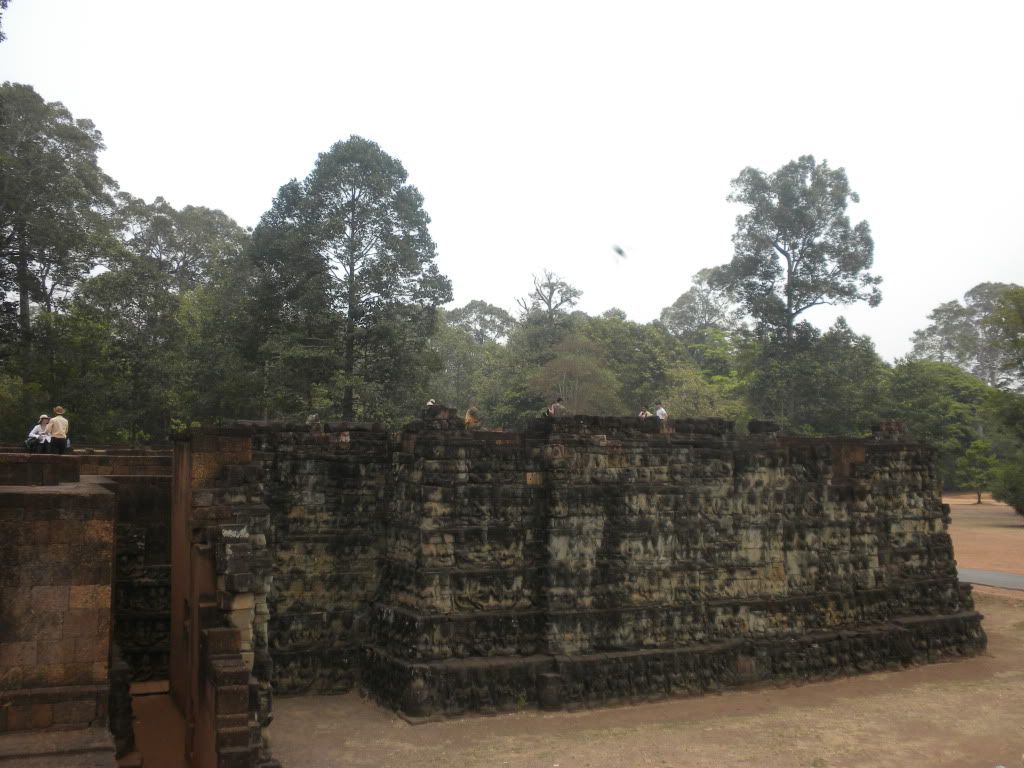
The coolest part of the Terrace was a small ‘tunnel,’ with detailed carvings of loads of Apsaras. On the far side the craftsmen hadn’t manage to finish the polishing of the dancers, leaving their bodies rough and showing us a little more about their skills.
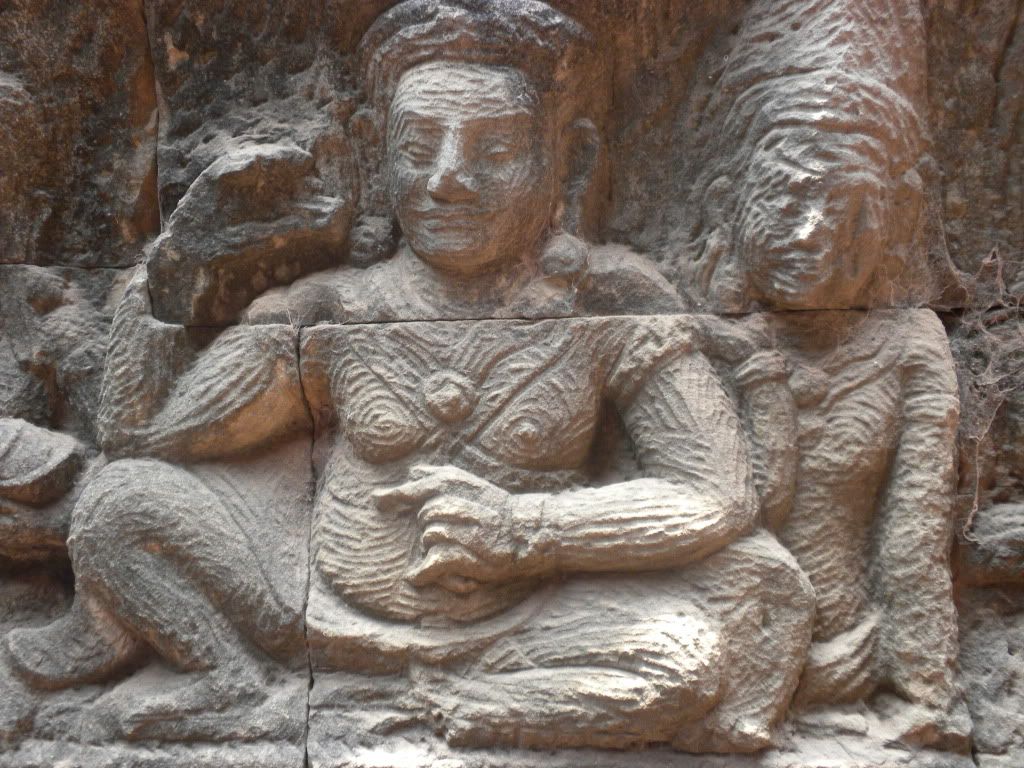
Next up was a duo of temples: Chau Say Tevoda and Thommanon, slightly less impressive temples. We went to Chau Say Tevoda first, finding the carvings of the Apsaras most impressive. On the way over to Thommanon Francesca was attacked by a little boy who tried to sell her a flute for a dollar. Francesca smiled and the boy continued. Soon she was offered 2 flutes and 4 bracelets for a dollar. It was hilarious to see the kid persist whilst Francesca kept saying no. Finally ridding ourselves of the kids we crossed the street and checked out Thommanon. Both temples were built around the time when work on Angkor Wat was begun and were dedicated to Shiva and Vishnu. Their designs were similar, composed of a sanctuary opening to the east onto a rectangular room, with two differing gopuras to the east and west, and a single “library” on the southern side.
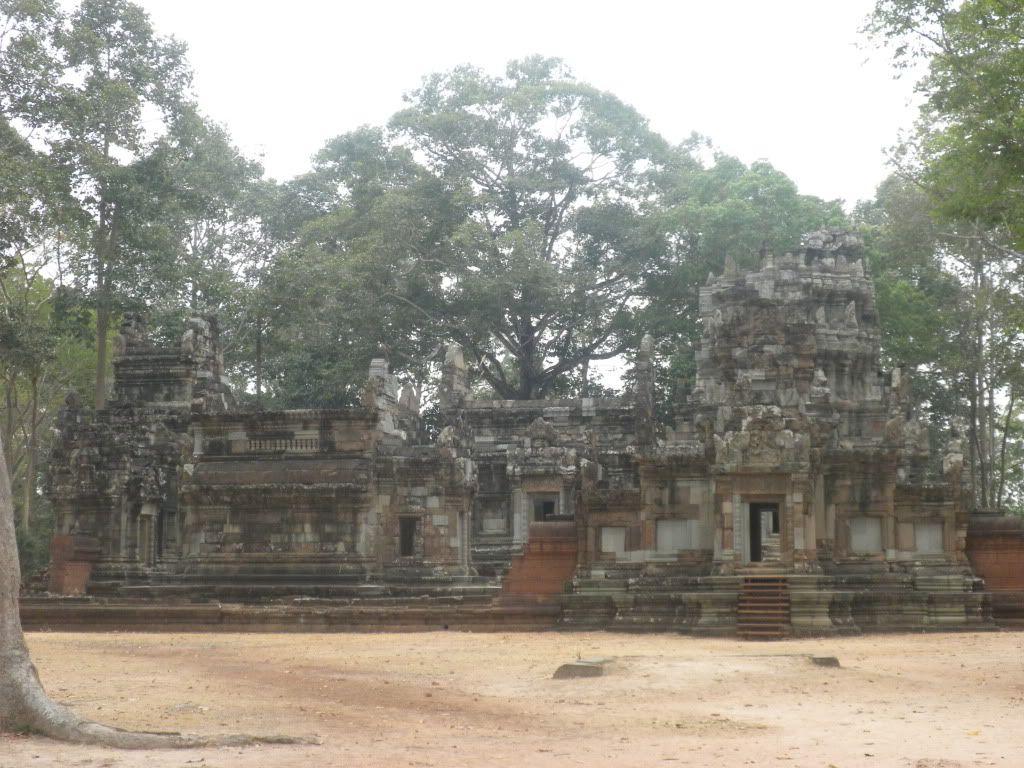
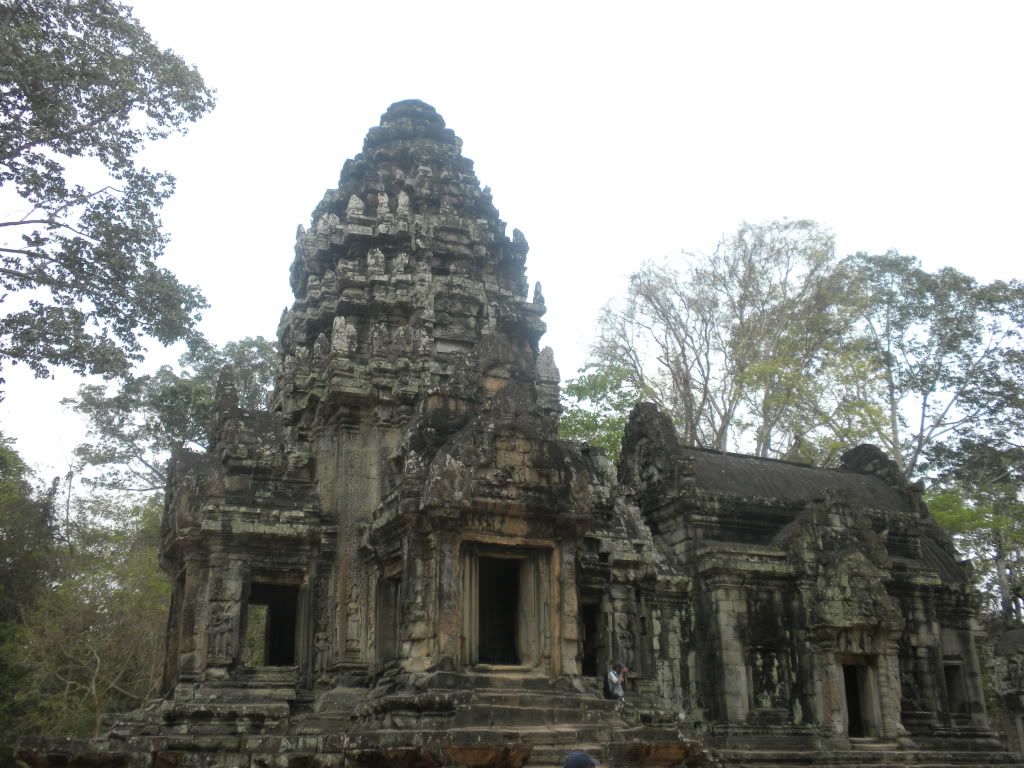
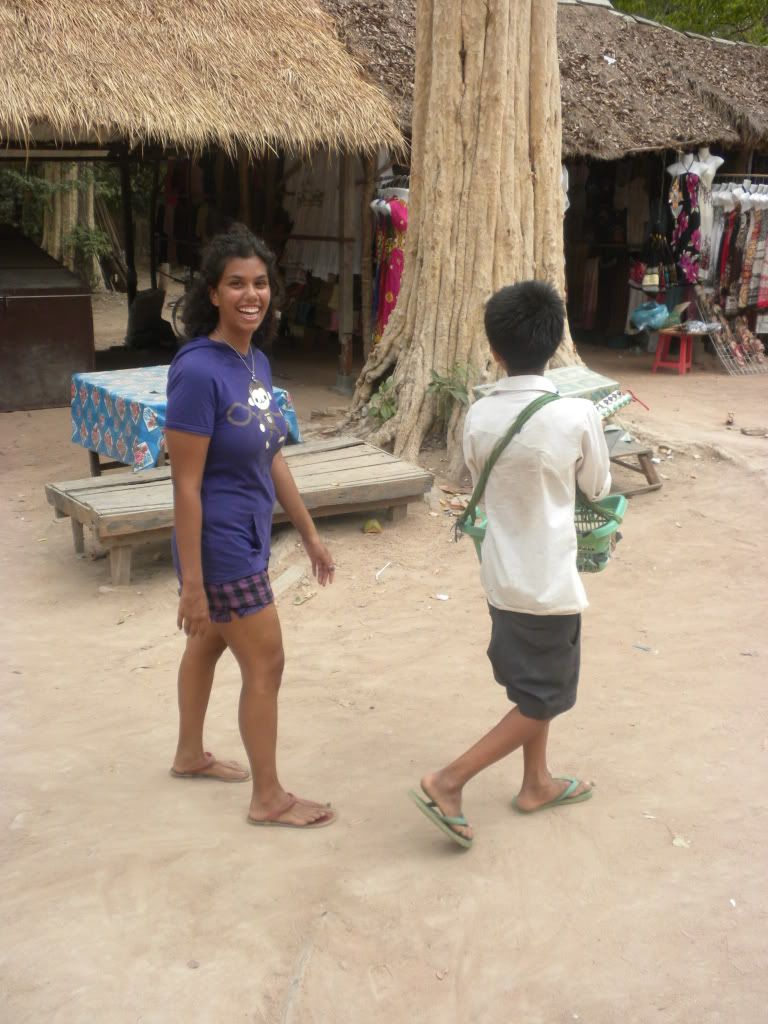
Tuk-tuk and Wanny were waiting for us, and we were taken to Ta Keo. Ta Keo is a temple-mountain, possibly the first to be built entirely of sandstone by Khmers. Wanny warned us of the steep steps, and then let us enjoy the sun by ourselves. Ta Keo had to be the state temple of Jayavarman V, who ended up never decorating Ta Keo. According to Wanny this was due to it being struck by lightning, which was seen as a bad omen. However, another likely reason may have been that the King died before its completion, where upon a struggle for succession followed. Francesca and I climbed the first big steps, ascending the 5 levels of the temples one at a time. The sun was really burning down on us, so reaching the top was a blessing. A little kid tied a red rope around our wrists and we had a look at the tiny statue inside. The way back down was fun too, with Francesca using the slide-on-your-ass technique to get down the steps.
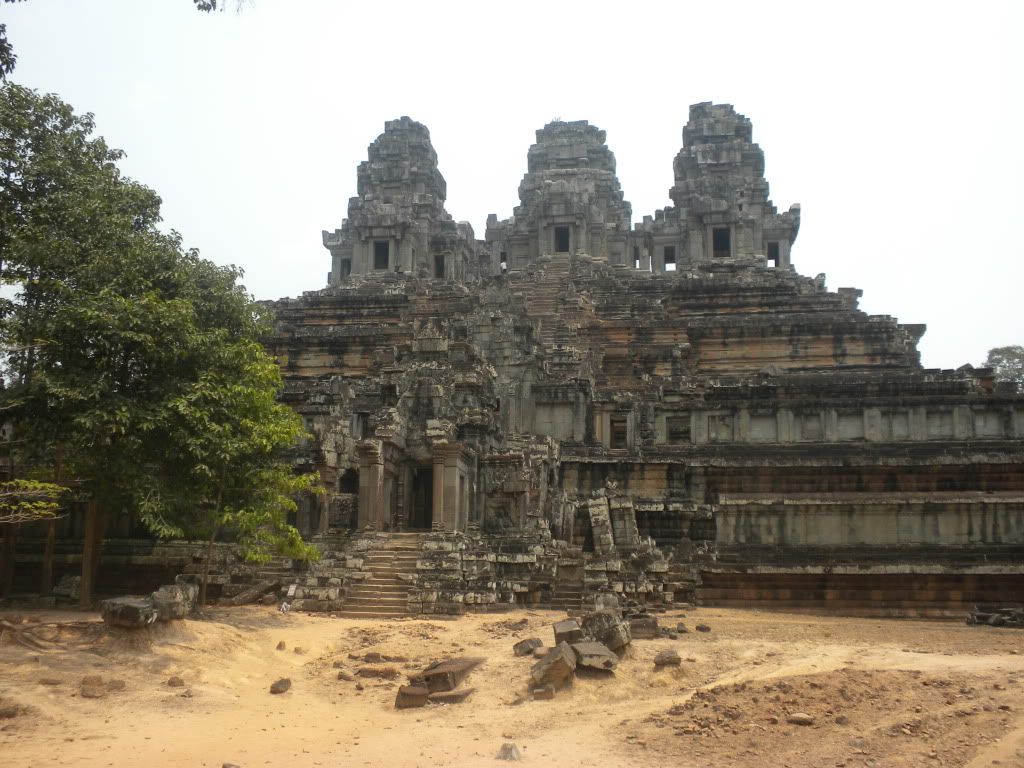
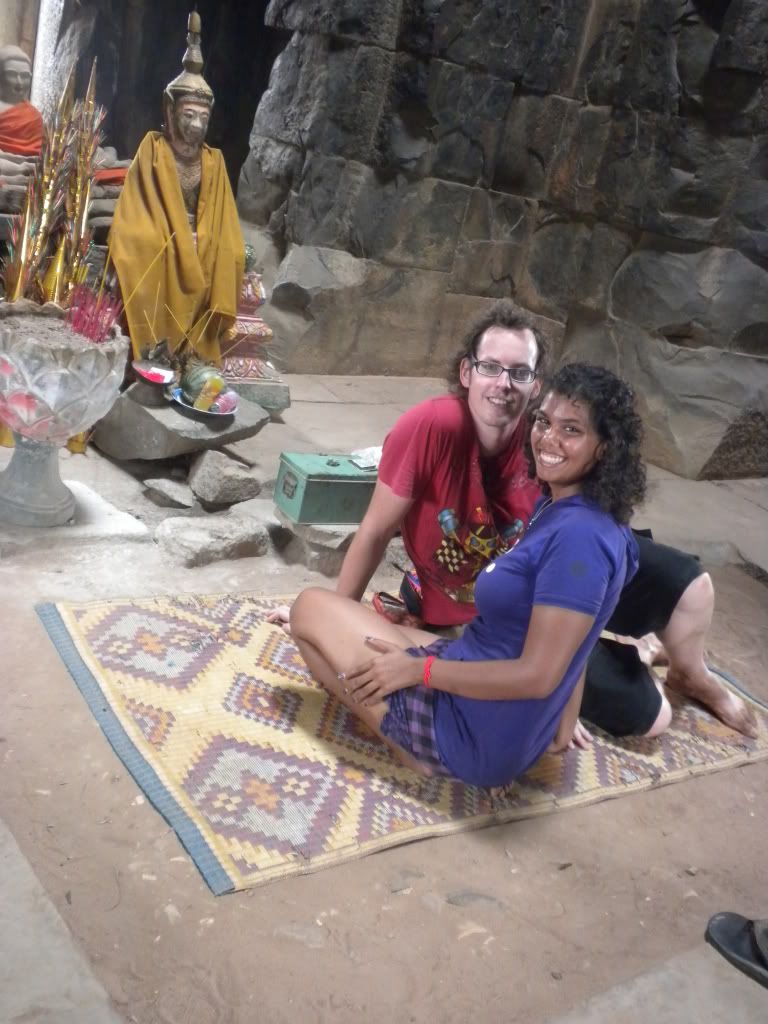
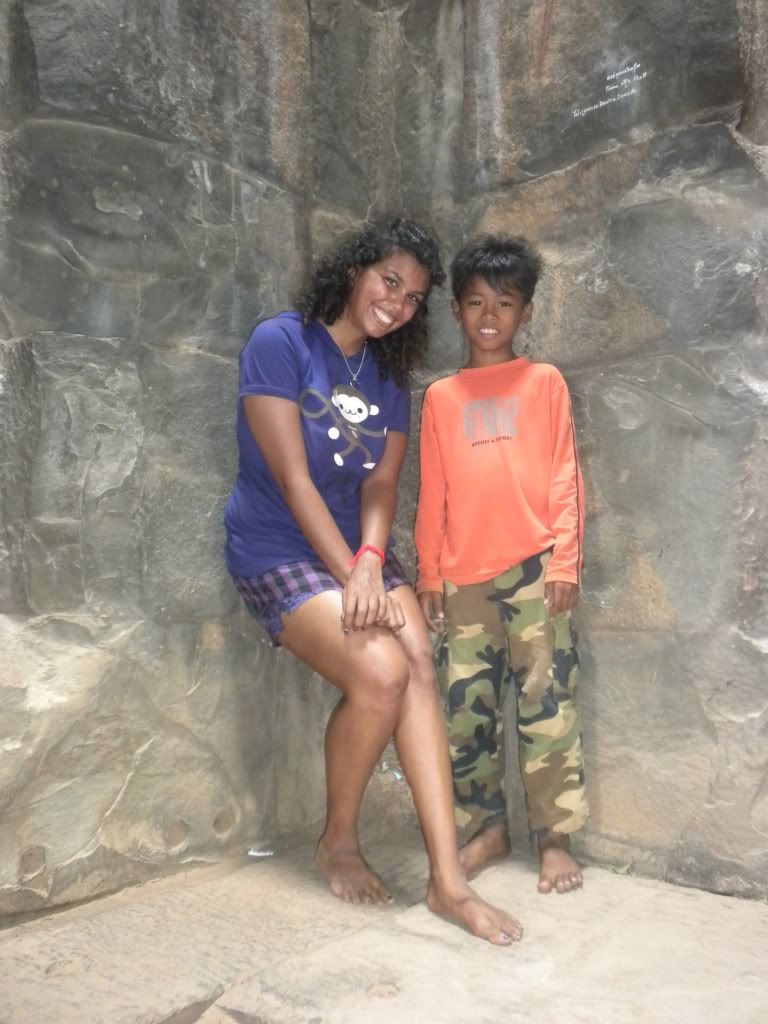
Just past 1:00 PM our little tuk-tuk troop reached Ta Phrom, or “Old Brahma.” The entrance gate looked down at us, a giant Bayon face covering its stones. It was founded by the Khmer King Jayavarman VII as a Mahayana Buddhist monastery and university. The temple's stele records that the site was home to more than 12,500 people (including 18 high priests and 615 dancers). Unlike most Angkorian temples, Ta Prohm has been left in much the same condition in which it was found: trees growing out of the ruins and the jungle surrounding it. We entered from the West, and immediately saw a large group of locals working on the restoration of the causeway and balustrade under Indian supervision. Large pieces of rocks were still lying around and it certainly looked like a difficult jigsaw to us.
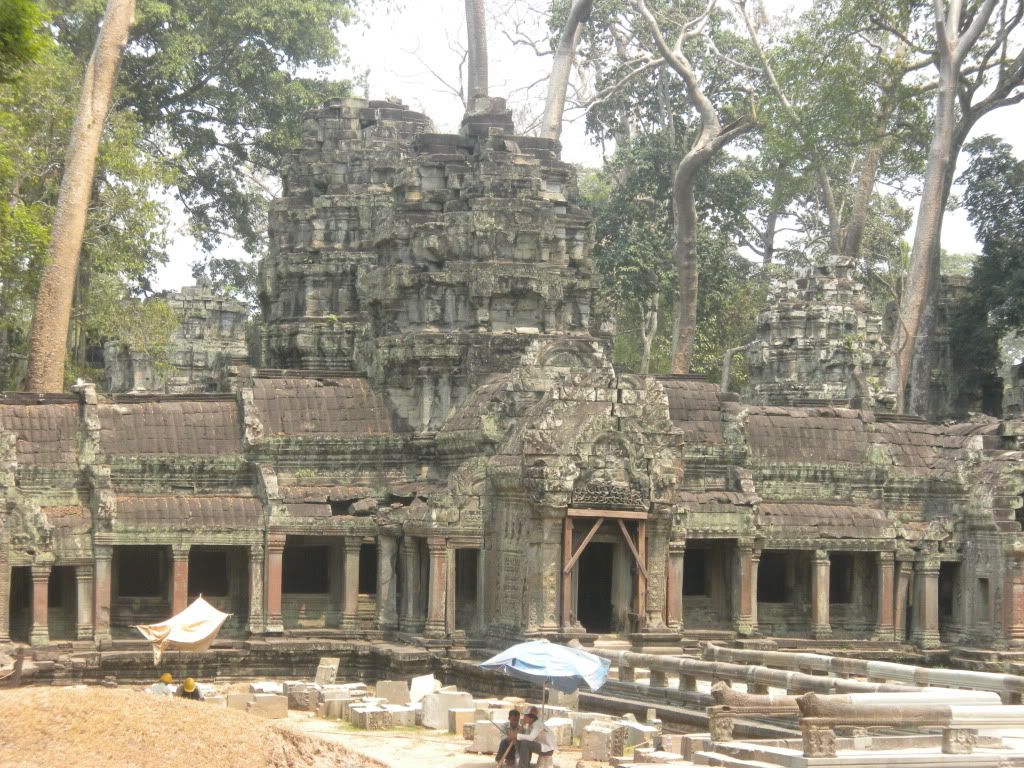

We passed the causeway on the left and headed for the temple proper. On our way there we got our first glimpse of the damage the trees were doing to the walls. The roots had overgrown the stones, pulling them over to one side as if they weighed nothing. In other places entire sections of the temple had been pushed over. Everywhere around us were stacks of grey stones huddled together, once standing strong together, but now sharing the floor in a chaos. Francesca and I were led from one giant tree to another whilst examining the remaining carvings. One highlight was the ‘Hidden Apsara;’ an Apsara almost entire overgrown by roots, only showing her face. When we reached the end of the temple we saw giant cranes working delicately with some of the larger pieces of stones on the floor, rebuilding libraries just outside of the temple.
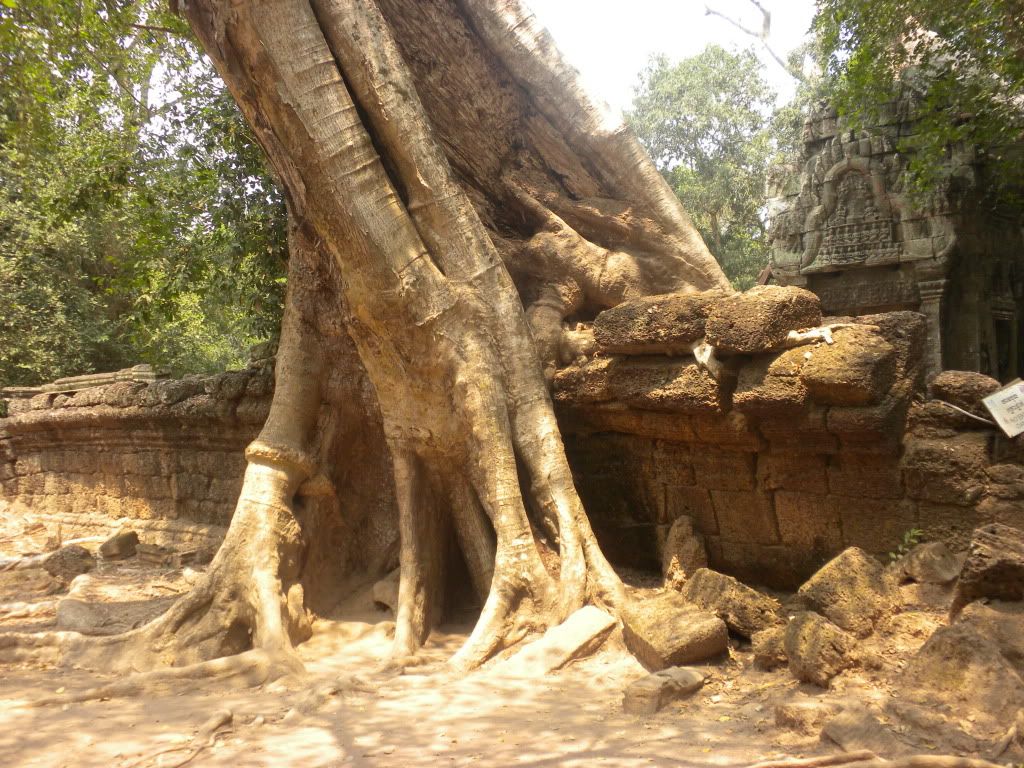
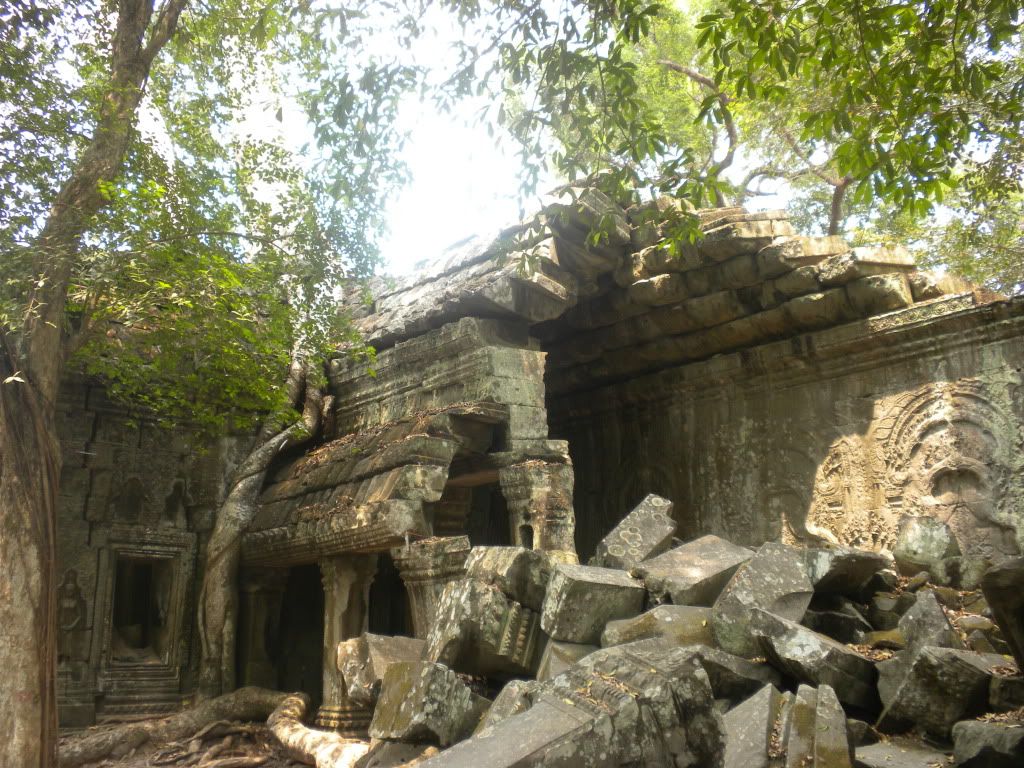
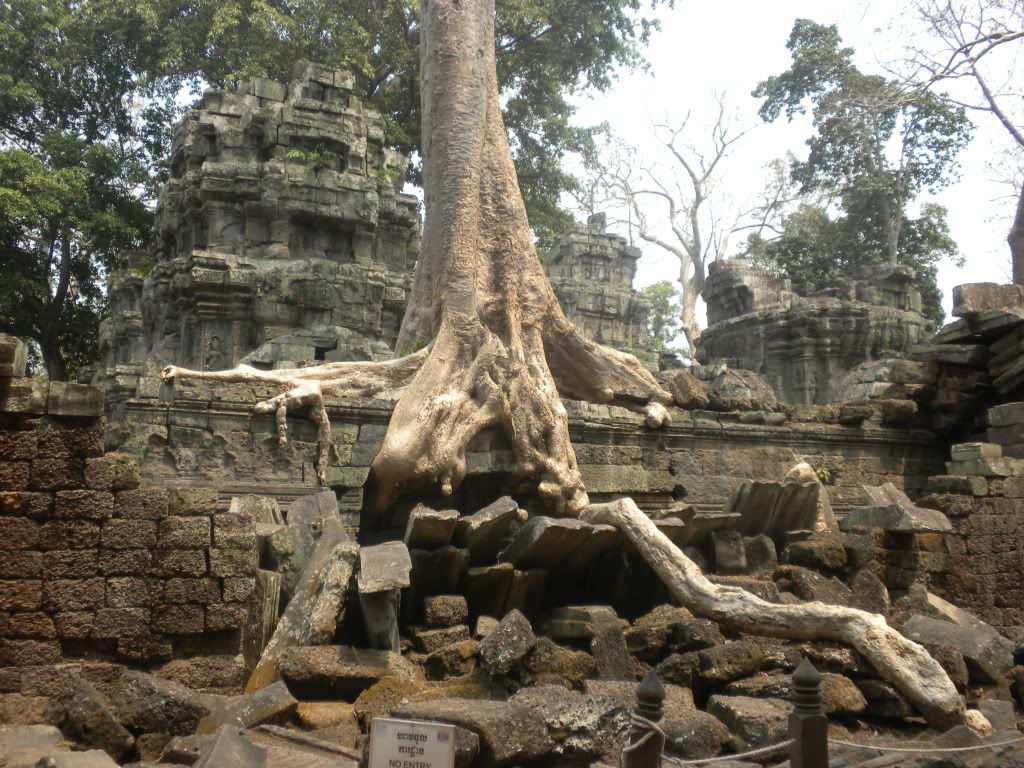
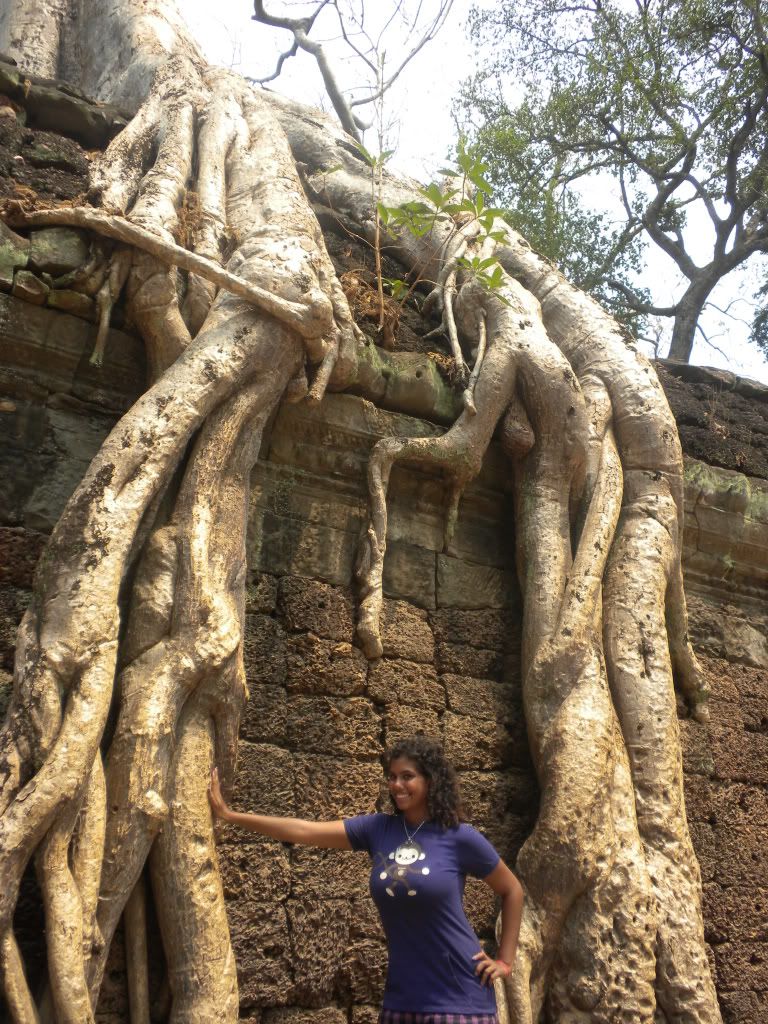
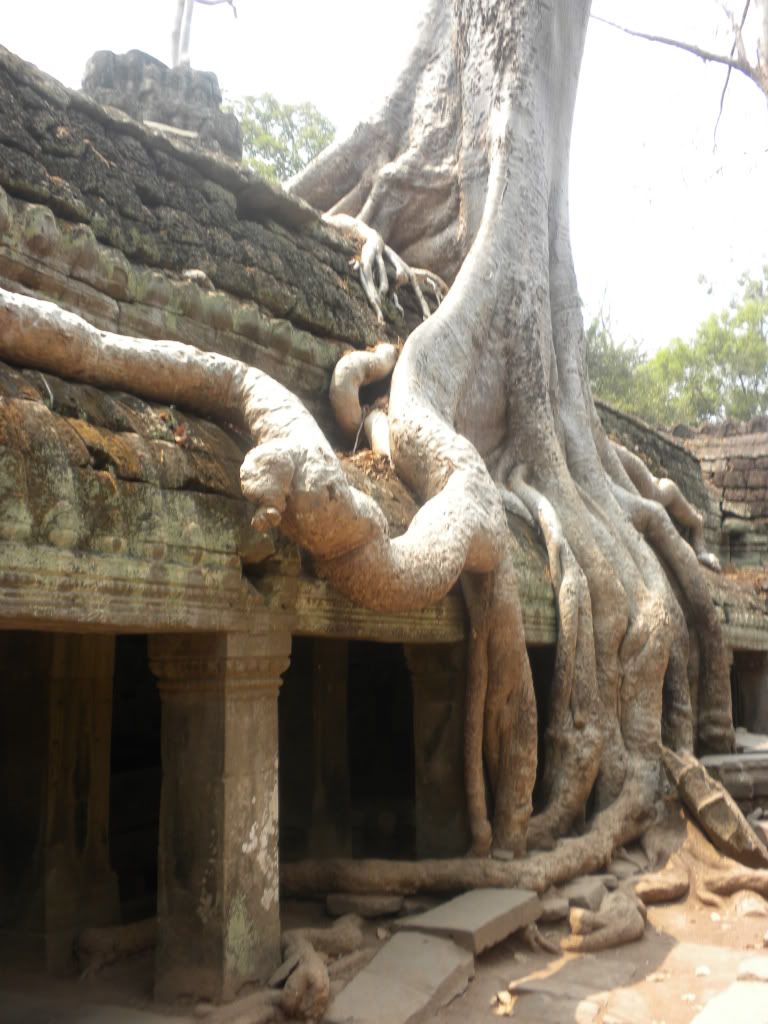
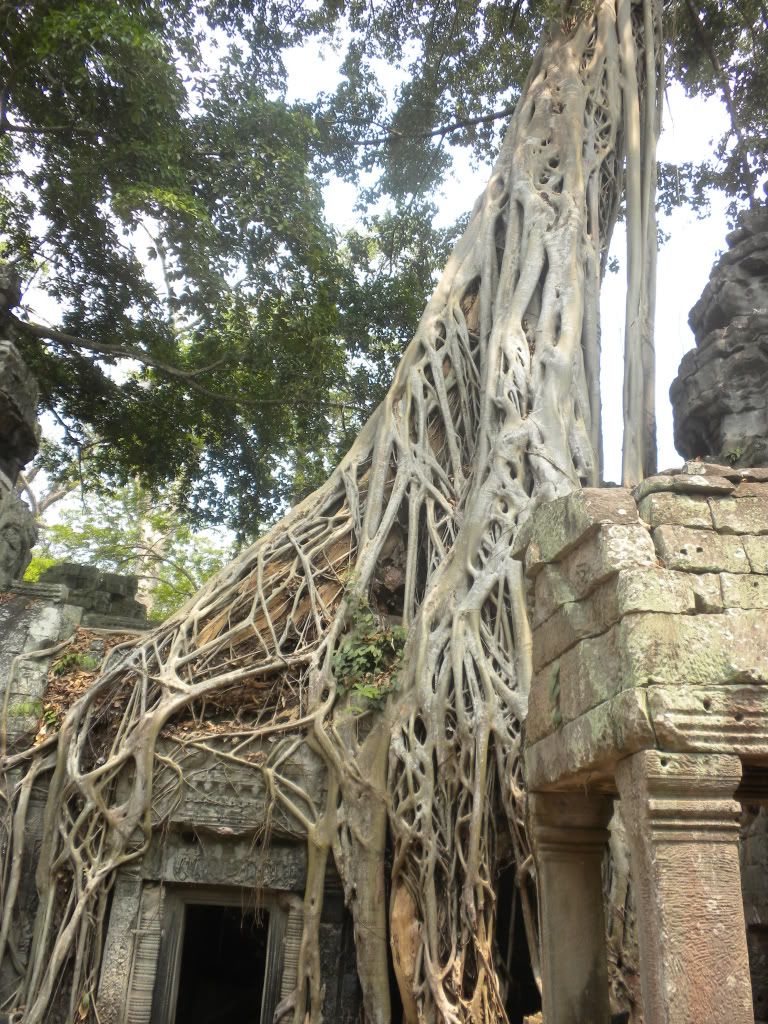
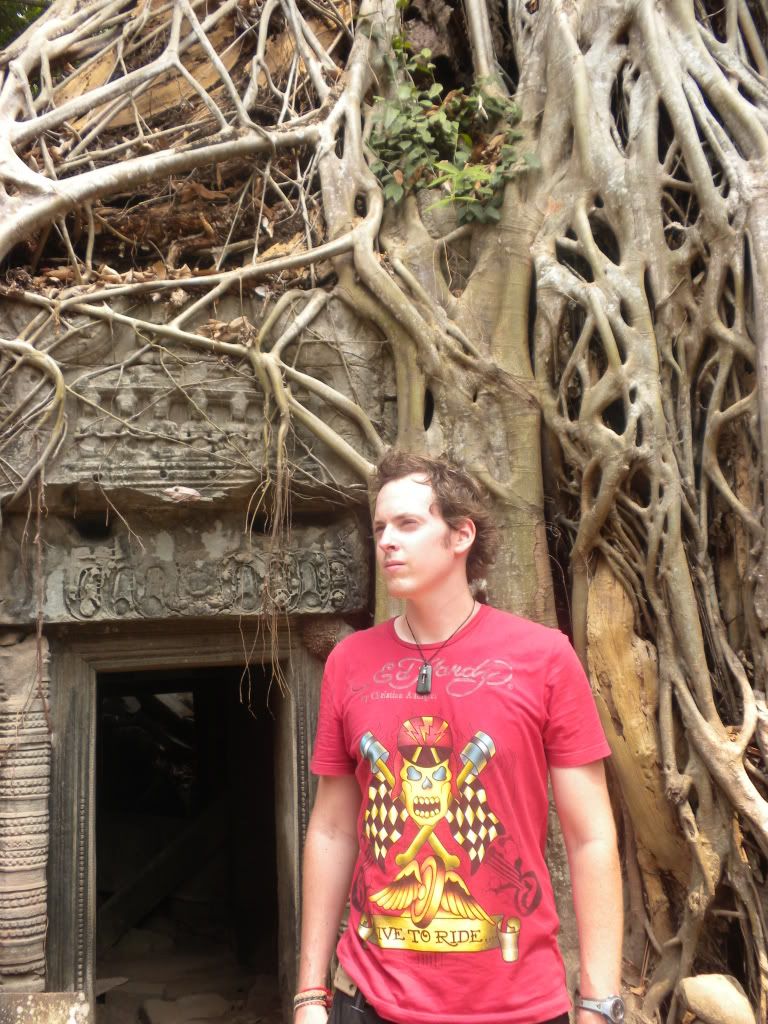
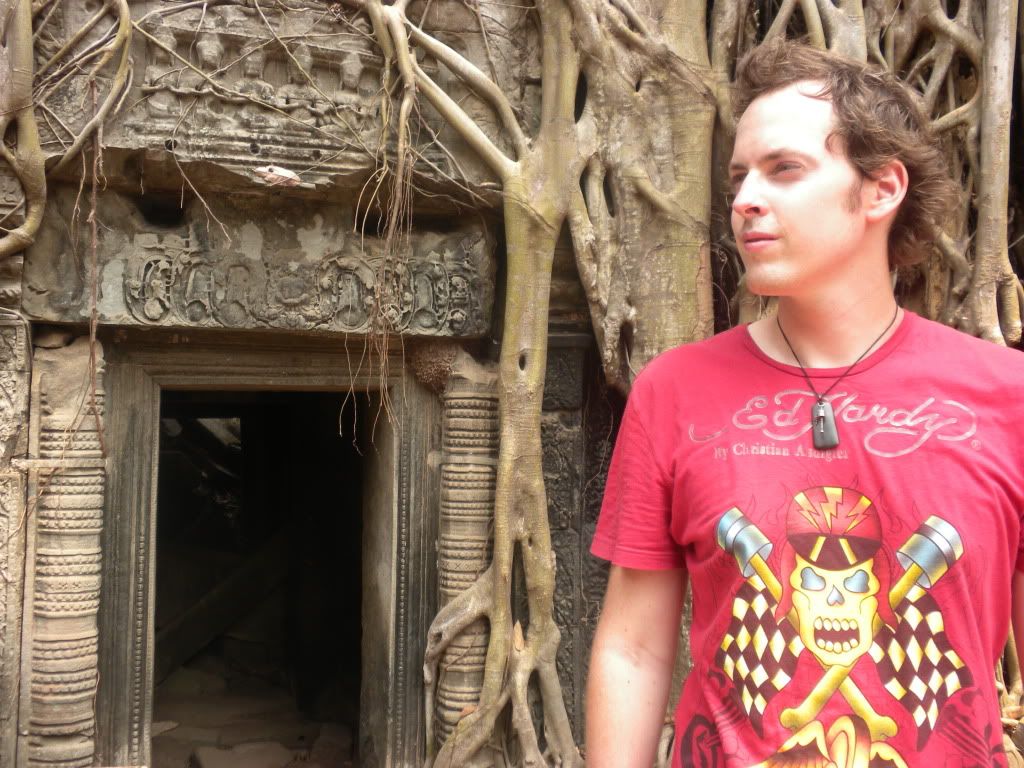
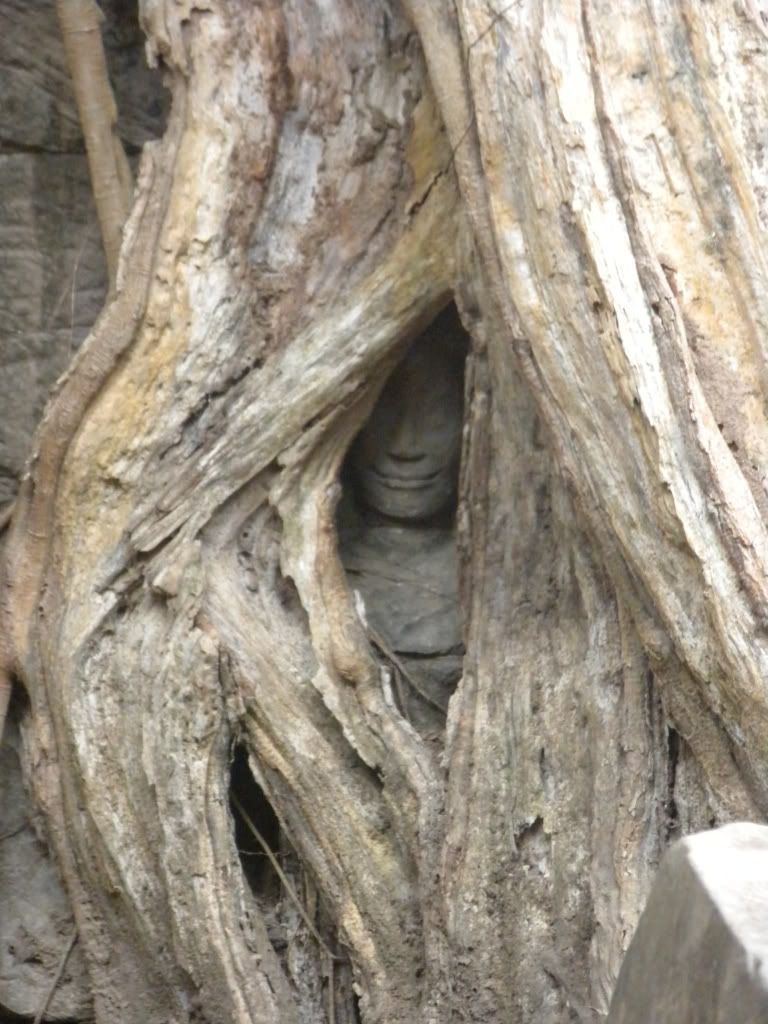
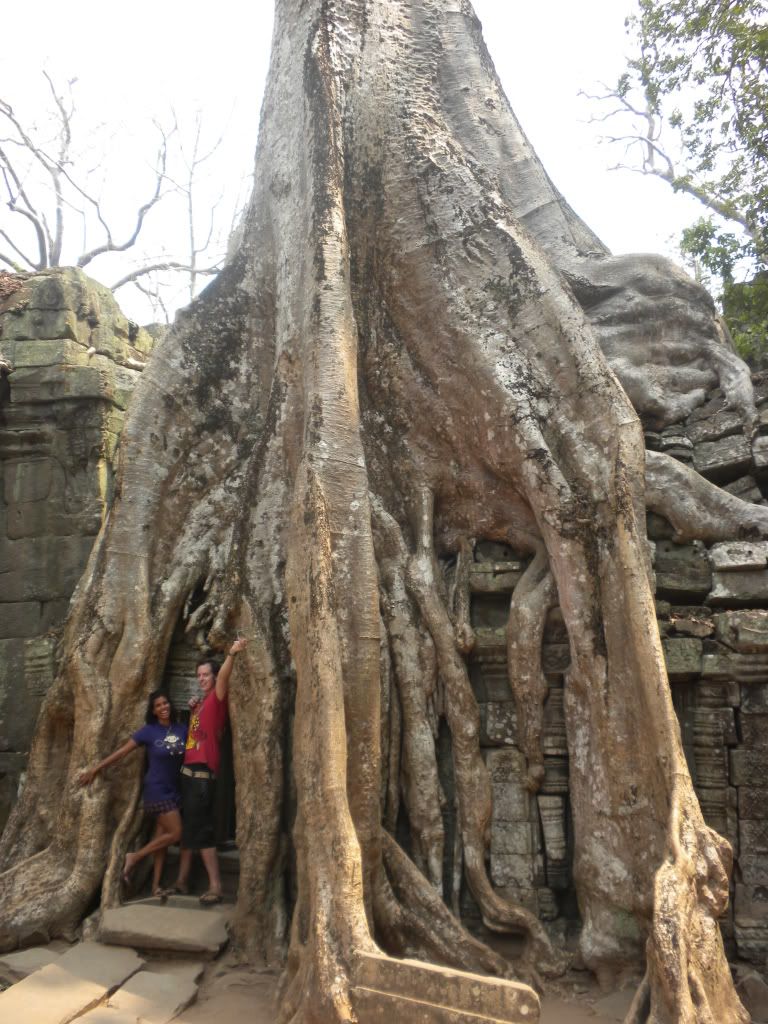
Back at the tuk-tuk Francesca and I were getting a little tired of our Angkor-exploring and decided to go back to the Shadow. We had one last temple we wanted to see on the way out: Banteay Kdei. This temple was also built during Jayavarman VII’s reign, and looked similar to Ta Phrom, if not less complex and smaller. The temple is also in a worse state than Ta Phrom, due to inferior sandstone and architecture. We were greeted once again by the smiling face of Jayavarman VII/Buddha and walked over the sandy road to the temple itself. We were greeted by some stone lions and walked around the compound for a while, before returning to Wanny and tuk-tuk man, who took us back to the city. We said goodbye to Wanny and thanked him for his stories, whilst making a deal with tuk-tuk man to meet us the next day for more exploring.
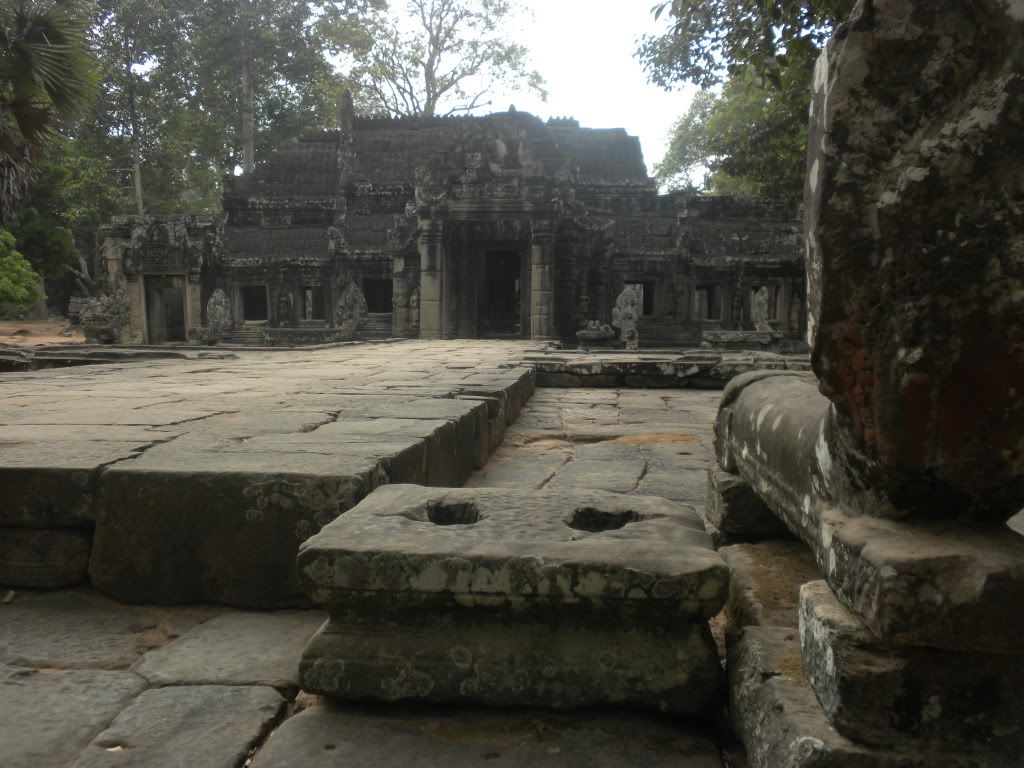
Francesca and I made it up the three floors of the Shadow, relaxed in our room for a few hours and even managed to take a quick dip in the small pool. Regrettably it had gotten quite cold outside, so before we knew it we were toweling off again and back in our room. I picked up some pizza for Francesca, whilst ordering a salad for myself that evening. Francesca and I went to bed pretty early thanks to our even earlier rise, discussing the day and marveling over the beautiful things we had seen.

1 Comments:
Bedankt voor de verhalen. Ik moet ze nog lezen,want ik was er gisteren niet en vandaag is het weer werken geblazen. Francesca, die foto in die lijst,zo lijkt het tenminste heb ik al als achtergrond. Heel veel liefs Oma xxx
Post a Comment
<< Home